
Want to create or adapt books like this? Learn more about how Pressbooks supports open publishing practices.
Chapter 11: Presenting Your Research

Writing a Research Report in American Psychological Association (APA) Style
Learning Objectives
- Identify the major sections of an APA-style research report and the basic contents of each section.
- Plan and write an effective APA-style research report.
In this section, we look at how to write an APA-style empirical research report , an article that presents the results of one or more new studies. Recall that the standard sections of an empirical research report provide a kind of outline. Here we consider each of these sections in detail, including what information it contains, how that information is formatted and organized, and tips for writing each section. At the end of this section is a sample APA-style research report that illustrates many of these principles.
Sections of a Research Report
Title page and abstract.
An APA-style research report begins with a title page . The title is centred in the upper half of the page, with each important word capitalized. The title should clearly and concisely (in about 12 words or fewer) communicate the primary variables and research questions. This sometimes requires a main title followed by a subtitle that elaborates on the main title, in which case the main title and subtitle are separated by a colon. Here are some titles from recent issues of professional journals published by the American Psychological Association.
- Sex Differences in Coping Styles and Implications for Depressed Mood
- Effects of Aging and Divided Attention on Memory for Items and Their Contexts
- Computer-Assisted Cognitive Behavioural Therapy for Child Anxiety: Results of a Randomized Clinical Trial
- Virtual Driving and Risk Taking: Do Racing Games Increase Risk-Taking Cognitions, Affect, and Behaviour?
Below the title are the authors’ names and, on the next line, their institutional affiliation—the university or other institution where the authors worked when they conducted the research. As we have already seen, the authors are listed in an order that reflects their contribution to the research. When multiple authors have made equal contributions to the research, they often list their names alphabetically or in a randomly determined order.
In some areas of psychology, the titles of many empirical research reports are informal in a way that is perhaps best described as “cute.” They usually take the form of a play on words or a well-known expression that relates to the topic under study. Here are some examples from recent issues of the Journal Psychological Science .
- “Smells Like Clean Spirit: Nonconscious Effects of Scent on Cognition and Behavior”
- “Time Crawls: The Temporal Resolution of Infants’ Visual Attention”
- “Scent of a Woman: Men’s Testosterone Responses to Olfactory Ovulation Cues”
- “Apocalypse Soon?: Dire Messages Reduce Belief in Global Warming by Contradicting Just-World Beliefs”
- “Serial vs. Parallel Processing: Sometimes They Look Like Tweedledum and Tweedledee but They Can (and Should) Be Distinguished”
- “How Do I Love Thee? Let Me Count the Words: The Social Effects of Expressive Writing”
Individual researchers differ quite a bit in their preference for such titles. Some use them regularly, while others never use them. What might be some of the pros and cons of using cute article titles?
For articles that are being submitted for publication, the title page also includes an author note that lists the authors’ full institutional affiliations, any acknowledgments the authors wish to make to agencies that funded the research or to colleagues who commented on it, and contact information for the authors. For student papers that are not being submitted for publication—including theses—author notes are generally not necessary.
The abstract is a summary of the study. It is the second page of the manuscript and is headed with the word Abstract . The first line is not indented. The abstract presents the research question, a summary of the method, the basic results, and the most important conclusions. Because the abstract is usually limited to about 200 words, it can be a challenge to write a good one.
Introduction
The introduction begins on the third page of the manuscript. The heading at the top of this page is the full title of the manuscript, with each important word capitalized as on the title page. The introduction includes three distinct subsections, although these are typically not identified by separate headings. The opening introduces the research question and explains why it is interesting, the literature review discusses relevant previous research, and the closing restates the research question and comments on the method used to answer it.
The Opening
The opening , which is usually a paragraph or two in length, introduces the research question and explains why it is interesting. To capture the reader’s attention, researcher Daryl Bem recommends starting with general observations about the topic under study, expressed in ordinary language (not technical jargon)—observations that are about people and their behaviour (not about researchers or their research; Bem, 2003 [1] ). Concrete examples are often very useful here. According to Bem, this would be a poor way to begin a research report:
Festinger’s theory of cognitive dissonance received a great deal of attention during the latter part of the 20th century (p. 191)
The following would be much better:
The individual who holds two beliefs that are inconsistent with one another may feel uncomfortable. For example, the person who knows that he or she enjoys smoking but believes it to be unhealthy may experience discomfort arising from the inconsistency or disharmony between these two thoughts or cognitions. This feeling of discomfort was called cognitive dissonance by social psychologist Leon Festinger (1957), who suggested that individuals will be motivated to remove this dissonance in whatever way they can (p. 191).
After capturing the reader’s attention, the opening should go on to introduce the research question and explain why it is interesting. Will the answer fill a gap in the literature? Will it provide a test of an important theory? Does it have practical implications? Giving readers a clear sense of what the research is about and why they should care about it will motivate them to continue reading the literature review—and will help them make sense of it.
Breaking the Rules
Researcher Larry Jacoby reported several studies showing that a word that people see or hear repeatedly can seem more familiar even when they do not recall the repetitions—and that this tendency is especially pronounced among older adults. He opened his article with the following humourous anecdote:
A friend whose mother is suffering symptoms of Alzheimer’s disease (AD) tells the story of taking her mother to visit a nursing home, preliminary to her mother’s moving there. During an orientation meeting at the nursing home, the rules and regulations were explained, one of which regarded the dining room. The dining room was described as similar to a fine restaurant except that tipping was not required. The absence of tipping was a central theme in the orientation lecture, mentioned frequently to emphasize the quality of care along with the advantages of having paid in advance. At the end of the meeting, the friend’s mother was asked whether she had any questions. She replied that she only had one question: “Should I tip?” (Jacoby, 1999, p. 3)
Although both humour and personal anecdotes are generally discouraged in APA-style writing, this example is a highly effective way to start because it both engages the reader and provides an excellent real-world example of the topic under study.
The Literature Review
Immediately after the opening comes the literature review , which describes relevant previous research on the topic and can be anywhere from several paragraphs to several pages in length. However, the literature review is not simply a list of past studies. Instead, it constitutes a kind of argument for why the research question is worth addressing. By the end of the literature review, readers should be convinced that the research question makes sense and that the present study is a logical next step in the ongoing research process.
Like any effective argument, the literature review must have some kind of structure. For example, it might begin by describing a phenomenon in a general way along with several studies that demonstrate it, then describing two or more competing theories of the phenomenon, and finally presenting a hypothesis to test one or more of the theories. Or it might describe one phenomenon, then describe another phenomenon that seems inconsistent with the first one, then propose a theory that resolves the inconsistency, and finally present a hypothesis to test that theory. In applied research, it might describe a phenomenon or theory, then describe how that phenomenon or theory applies to some important real-world situation, and finally suggest a way to test whether it does, in fact, apply to that situation.
Looking at the literature review in this way emphasizes a few things. First, it is extremely important to start with an outline of the main points that you want to make, organized in the order that you want to make them. The basic structure of your argument, then, should be apparent from the outline itself. Second, it is important to emphasize the structure of your argument in your writing. One way to do this is to begin the literature review by summarizing your argument even before you begin to make it. “In this article, I will describe two apparently contradictory phenomena, present a new theory that has the potential to resolve the apparent contradiction, and finally present a novel hypothesis to test the theory.” Another way is to open each paragraph with a sentence that summarizes the main point of the paragraph and links it to the preceding points. These opening sentences provide the “transitions” that many beginning researchers have difficulty with. Instead of beginning a paragraph by launching into a description of a previous study, such as “Williams (2004) found that…,” it is better to start by indicating something about why you are describing this particular study. Here are some simple examples:
Another example of this phenomenon comes from the work of Williams (2004).
Williams (2004) offers one explanation of this phenomenon.
An alternative perspective has been provided by Williams (2004).
We used a method based on the one used by Williams (2004).
Finally, remember that your goal is to construct an argument for why your research question is interesting and worth addressing—not necessarily why your favourite answer to it is correct. In other words, your literature review must be balanced. If you want to emphasize the generality of a phenomenon, then of course you should discuss various studies that have demonstrated it. However, if there are other studies that have failed to demonstrate it, you should discuss them too. Or if you are proposing a new theory, then of course you should discuss findings that are consistent with that theory. However, if there are other findings that are inconsistent with it, again, you should discuss them too. It is acceptable to argue that the balance of the research supports the existence of a phenomenon or is consistent with a theory (and that is usually the best that researchers in psychology can hope for), but it is not acceptable to ignore contradictory evidence. Besides, a large part of what makes a research question interesting is uncertainty about its answer.
The Closing
The closing of the introduction—typically the final paragraph or two—usually includes two important elements. The first is a clear statement of the main research question or hypothesis. This statement tends to be more formal and precise than in the opening and is often expressed in terms of operational definitions of the key variables. The second is a brief overview of the method and some comment on its appropriateness. Here, for example, is how Darley and Latané (1968) [2] concluded the introduction to their classic article on the bystander effect:
These considerations lead to the hypothesis that the more bystanders to an emergency, the less likely, or the more slowly, any one bystander will intervene to provide aid. To test this proposition it would be necessary to create a situation in which a realistic “emergency” could plausibly occur. Each subject should also be blocked from communicating with others to prevent his getting information about their behaviour during the emergency. Finally, the experimental situation should allow for the assessment of the speed and frequency of the subjects’ reaction to the emergency. The experiment reported below attempted to fulfill these conditions. (p. 378)
Thus the introduction leads smoothly into the next major section of the article—the method section.
The method section is where you describe how you conducted your study. An important principle for writing a method section is that it should be clear and detailed enough that other researchers could replicate the study by following your “recipe.” This means that it must describe all the important elements of the study—basic demographic characteristics of the participants, how they were recruited, whether they were randomly assigned, how the variables were manipulated or measured, how counterbalancing was accomplished, and so on. At the same time, it should avoid irrelevant details such as the fact that the study was conducted in Classroom 37B of the Industrial Technology Building or that the questionnaire was double-sided and completed using pencils.
The method section begins immediately after the introduction ends with the heading “Method” (not “Methods”) centred on the page. Immediately after this is the subheading “Participants,” left justified and in italics. The participants subsection indicates how many participants there were, the number of women and men, some indication of their age, other demographics that may be relevant to the study, and how they were recruited, including any incentives given for participation.

After the participants section, the structure can vary a bit. Figure 11.1 shows three common approaches. In the first, the participants section is followed by a design and procedure subsection, which describes the rest of the method. This works well for methods that are relatively simple and can be described adequately in a few paragraphs. In the second approach, the participants section is followed by separate design and procedure subsections. This works well when both the design and the procedure are relatively complicated and each requires multiple paragraphs.
What is the difference between design and procedure? The design of a study is its overall structure. What were the independent and dependent variables? Was the independent variable manipulated, and if so, was it manipulated between or within subjects? How were the variables operationally defined? The procedure is how the study was carried out. It often works well to describe the procedure in terms of what the participants did rather than what the researchers did. For example, the participants gave their informed consent, read a set of instructions, completed a block of four practice trials, completed a block of 20 test trials, completed two questionnaires, and were debriefed and excused.
In the third basic way to organize a method section, the participants subsection is followed by a materials subsection before the design and procedure subsections. This works well when there are complicated materials to describe. This might mean multiple questionnaires, written vignettes that participants read and respond to, perceptual stimuli, and so on. The heading of this subsection can be modified to reflect its content. Instead of “Materials,” it can be “Questionnaires,” “Stimuli,” and so on.
The results section is where you present the main results of the study, including the results of the statistical analyses. Although it does not include the raw data—individual participants’ responses or scores—researchers should save their raw data and make them available to other researchers who request them. Several journals now encourage the open sharing of raw data online.
Although there are no standard subsections, it is still important for the results section to be logically organized. Typically it begins with certain preliminary issues. One is whether any participants or responses were excluded from the analyses and why. The rationale for excluding data should be described clearly so that other researchers can decide whether it is appropriate. A second preliminary issue is how multiple responses were combined to produce the primary variables in the analyses. For example, if participants rated the attractiveness of 20 stimulus people, you might have to explain that you began by computing the mean attractiveness rating for each participant. Or if they recalled as many items as they could from study list of 20 words, did you count the number correctly recalled, compute the percentage correctly recalled, or perhaps compute the number correct minus the number incorrect? A third preliminary issue is the reliability of the measures. This is where you would present test-retest correlations, Cronbach’s α, or other statistics to show that the measures are consistent across time and across items. A final preliminary issue is whether the manipulation was successful. This is where you would report the results of any manipulation checks.
The results section should then tackle the primary research questions, one at a time. Again, there should be a clear organization. One approach would be to answer the most general questions and then proceed to answer more specific ones. Another would be to answer the main question first and then to answer secondary ones. Regardless, Bem (2003) [3] suggests the following basic structure for discussing each new result:
- Remind the reader of the research question.
- Give the answer to the research question in words.
- Present the relevant statistics.
- Qualify the answer if necessary.
- Summarize the result.
Notice that only Step 3 necessarily involves numbers. The rest of the steps involve presenting the research question and the answer to it in words. In fact, the basic results should be clear even to a reader who skips over the numbers.
The discussion is the last major section of the research report. Discussions usually consist of some combination of the following elements:
- Summary of the research
- Theoretical implications
- Practical implications
- Limitations
- Suggestions for future research
The discussion typically begins with a summary of the study that provides a clear answer to the research question. In a short report with a single study, this might require no more than a sentence. In a longer report with multiple studies, it might require a paragraph or even two. The summary is often followed by a discussion of the theoretical implications of the research. Do the results provide support for any existing theories? If not, how can they be explained? Although you do not have to provide a definitive explanation or detailed theory for your results, you at least need to outline one or more possible explanations. In applied research—and often in basic research—there is also some discussion of the practical implications of the research. How can the results be used, and by whom, to accomplish some real-world goal?
The theoretical and practical implications are often followed by a discussion of the study’s limitations. Perhaps there are problems with its internal or external validity. Perhaps the manipulation was not very effective or the measures not very reliable. Perhaps there is some evidence that participants did not fully understand their task or that they were suspicious of the intent of the researchers. Now is the time to discuss these issues and how they might have affected the results. But do not overdo it. All studies have limitations, and most readers will understand that a different sample or different measures might have produced different results. Unless there is good reason to think they would have, however, there is no reason to mention these routine issues. Instead, pick two or three limitations that seem like they could have influenced the results, explain how they could have influenced the results, and suggest ways to deal with them.
Most discussions end with some suggestions for future research. If the study did not satisfactorily answer the original research question, what will it take to do so? What new research questions has the study raised? This part of the discussion, however, is not just a list of new questions. It is a discussion of two or three of the most important unresolved issues. This means identifying and clarifying each question, suggesting some alternative answers, and even suggesting ways they could be studied.
Finally, some researchers are quite good at ending their articles with a sweeping or thought-provoking conclusion. Darley and Latané (1968) [4] , for example, ended their article on the bystander effect by discussing the idea that whether people help others may depend more on the situation than on their personalities. Their final sentence is, “If people understand the situational forces that can make them hesitate to intervene, they may better overcome them” (p. 383). However, this kind of ending can be difficult to pull off. It can sound overreaching or just banal and end up detracting from the overall impact of the article. It is often better simply to end when you have made your final point (although you should avoid ending on a limitation).
The references section begins on a new page with the heading “References” centred at the top of the page. All references cited in the text are then listed in the format presented earlier. They are listed alphabetically by the last name of the first author. If two sources have the same first author, they are listed alphabetically by the last name of the second author. If all the authors are the same, then they are listed chronologically by the year of publication. Everything in the reference list is double-spaced both within and between references.
Appendices, Tables, and Figures
Appendices, tables, and figures come after the references. An appendix is appropriate for supplemental material that would interrupt the flow of the research report if it were presented within any of the major sections. An appendix could be used to present lists of stimulus words, questionnaire items, detailed descriptions of special equipment or unusual statistical analyses, or references to the studies that are included in a meta-analysis. Each appendix begins on a new page. If there is only one, the heading is “Appendix,” centred at the top of the page. If there is more than one, the headings are “Appendix A,” “Appendix B,” and so on, and they appear in the order they were first mentioned in the text of the report.
After any appendices come tables and then figures. Tables and figures are both used to present results. Figures can also be used to illustrate theories (e.g., in the form of a flowchart), display stimuli, outline procedures, and present many other kinds of information. Each table and figure appears on its own page. Tables are numbered in the order that they are first mentioned in the text (“Table 1,” “Table 2,” and so on). Figures are numbered the same way (“Figure 1,” “Figure 2,” and so on). A brief explanatory title, with the important words capitalized, appears above each table. Each figure is given a brief explanatory caption, where (aside from proper nouns or names) only the first word of each sentence is capitalized. More details on preparing APA-style tables and figures are presented later in the book.
Sample APA-Style Research Report
Figures 11.2, 11.3, 11.4, and 11.5 show some sample pages from an APA-style empirical research report originally written by undergraduate student Tomoe Suyama at California State University, Fresno. The main purpose of these figures is to illustrate the basic organization and formatting of an APA-style empirical research report, although many high-level and low-level style conventions can be seen here too.

Key Takeaways
- An APA-style empirical research report consists of several standard sections. The main ones are the abstract, introduction, method, results, discussion, and references.
- The introduction consists of an opening that presents the research question, a literature review that describes previous research on the topic, and a closing that restates the research question and comments on the method. The literature review constitutes an argument for why the current study is worth doing.
- The method section describes the method in enough detail that another researcher could replicate the study. At a minimum, it consists of a participants subsection and a design and procedure subsection.
- The results section describes the results in an organized fashion. Each primary result is presented in terms of statistical results but also explained in words.
- The discussion typically summarizes the study, discusses theoretical and practical implications and limitations of the study, and offers suggestions for further research.
- Practice: Look through an issue of a general interest professional journal (e.g., Psychological Science ). Read the opening of the first five articles and rate the effectiveness of each one from 1 ( very ineffective ) to 5 ( very effective ). Write a sentence or two explaining each rating.
- Practice: Find a recent article in a professional journal and identify where the opening, literature review, and closing of the introduction begin and end.
- Practice: Find a recent article in a professional journal and highlight in a different colour each of the following elements in the discussion: summary, theoretical implications, practical implications, limitations, and suggestions for future research.
Long Descriptions
Figure 11.1 long description: Table showing three ways of organizing an APA-style method section.
In the simple method, there are two subheadings: “Participants” (which might begin “The participants were…”) and “Design and procedure” (which might begin “There were three conditions…”).
In the typical method, there are three subheadings: “Participants” (“The participants were…”), “Design” (“There were three conditions…”), and “Procedure” (“Participants viewed each stimulus on the computer screen…”).
In the complex method, there are four subheadings: “Participants” (“The participants were…”), “Materials” (“The stimuli were…”), “Design” (“There were three conditions…”), and “Procedure” (“Participants viewed each stimulus on the computer screen…”). [Return to Figure 11.1]
- Bem, D. J. (2003). Writing the empirical journal article. In J. M. Darley, M. P. Zanna, & H. R. Roediger III (Eds.), The compleat academic: A practical guide for the beginning social scientist (2nd ed.). Washington, DC: American Psychological Association. ↵
- Darley, J. M., & Latané, B. (1968). Bystander intervention in emergencies: Diffusion of responsibility. Journal of Personality and Social Psychology, 4 , 377–383. ↵
A type of research article which describes one or more new empirical studies conducted by the authors.
The page at the beginning of an APA-style research report containing the title of the article, the authors’ names, and their institutional affiliation.
A summary of a research study.
The third page of a manuscript containing the research question, the literature review, and comments about how to answer the research question.
An introduction to the research question and explanation for why this question is interesting.
A description of relevant previous research on the topic being discusses and an argument for why the research is worth addressing.
The end of the introduction, where the research question is reiterated and the method is commented upon.
The section of a research report where the method used to conduct the study is described.
The main results of the study, including the results from statistical analyses, are presented in a research article.
Section of a research report that summarizes the study's results and interprets them by referring back to the study's theoretical background.
Part of a research report which contains supplemental material.
Research Methods in Psychology - 2nd Canadian Edition Copyright © 2015 by Paul C. Price, Rajiv Jhangiani, & I-Chant A. Chiang is licensed under a Creative Commons Attribution-NonCommercial-ShareAlike 4.0 International License , except where otherwise noted.
Share This Book
- Bipolar Disorder
- Therapy Center
- When To See a Therapist
- Types of Therapy
- Best Online Therapy
- Best Couples Therapy
- Best Family Therapy
- Managing Stress
- Sleep and Dreaming
- Understanding Emotions
- Self-Improvement
- Healthy Relationships
- Student Resources
- Personality Types
- Guided Meditations
- Verywell Mind Insights
- 2024 Verywell Mind 25
- Mental Health in the Classroom
- Editorial Process
- Meet Our Review Board
- Crisis Support
How to Write a Psychology Lab Report
Kendra Cherry, MS, is a psychosocial rehabilitation specialist, psychology educator, and author of the "Everything Psychology Book."
:max_bytes(150000):strip_icc():format(webp)/IMG_9791-89504ab694d54b66bbd72cb84ffb860e.jpg)
James Lacy, MLS, is a fact-checker and researcher.
:max_bytes(150000):strip_icc():format(webp)/James-Lacy-1000-73de2239670146618c03f8b77f02f84e.jpg)
Introduction
Appendices and supplemental materials.
A psychology lab report is a paper that describes an experiment. A lab report is organized and written according to the format used in professional journal articles.
In your lab report, you will provide an overview of your findings, a background of the topic, your methods, and results. You'll also discuss your findings and your interpretations of the results.
At a Glance
A psychology lab report is structured in the same format as a professional journal article. It should include a:
- Method section
- Results section
- Discussion section
- Reference section
- Appendix and supplementary materials (if needed)
Title Page of a Psychology Lab Report
This will be the first page of your lab report. It should include important information such as the name of your paper, your name, and your academic affiliation.
Your title should be relatively brief and provide a good idea about what your paper is about. Avoid titles that are too general and don't provide a clear description of what your lab report contains.
For example, instead of something general like "An experiment on memory," your title should be more clear and focused, such as, "The effects of sleep deprivation on short-term memory in college students."
Page two of your lab report will be an abstract . The abstract is a brief description of what you set out to find in your research, how you went about it, and a general statement describing your findings.
Think of the abstract of your psychology lab report as a succinct summary of your experiment. It should explain your study's objectives, how you conducted the experiments, and what you discovered.
According to the American Psychological Association (APA) style guide, for most lab reports, the abstract should be kept to 250 words. However, the specific word count and format of abstract could vary depending on your instructor or the academic journal in which you plan to publish.
Your paper should begin with an introduction that describes previous findings regarding your topic of interest, explains the goals of your current research, and describes your hypothesis —what you expect to discover as a result of your research.
In this section, you essentially explain to your reader why you chose to do your experiment. If should give a good background on the topic, so that readers can get an idea about why your study will help fill a gap in our current understanding.
Your introduction will likely be several pages long to provide a thorough and sufficient overview of past research. You don't need to cover all of the research on the topic, but you should give readers a good overview of past research and findings.
The introduction of your psychology lab report should summarize the research and help readers understand why you are choosing to address new questions in your research. Be sure to cite all sources using proper APA format.
The next section of your lab report will be the method section . In this portion of your report, you will describe the procedures you used in your research. You'll include specific information such as the number of participants in your study, the background of each individual, your independent and dependent variables , and the type of experimental design you used.
The method section of a psychology lab report should be broken down into several different sub-sections:
- Design : Describe the type of experimental design that you used
- Participants : Describe the participants in your study, including their age, sex, and other characteristics
- Apparatus : Describe any tools or resources that you used while conducting your experiment, such as equipment or questionnaires
- Procedure : Provide the exact procedures that you used while carrying out your experiment
In the results section of your lab report, you'll describe the statistical data you gathered from your research. This section will likely be quite short; you don't need to include any interpretation of your results.
The goal of this part of your psychology lab report is to provide your results without trying to interpret what they might mean.
You should also include tables and figures to display statistical data and results. Be sure to only include tables and figures that you will talk about in the text.
The results section will likely be one of the shortest sections of your lab report. However, this might vary depending on how complex your experiment was and the type of statistical analyses you used.
Next, your lab report should include a discussion section. Here you'll interpret the results of your experiment and state whether your findings support your hypothesis.
You should start this section by once again stating your main results and whether or not they support the hypothesis you stated in your introduction.
You can also discuss how the results of your experiment relate to previous findings. You also should offer possible explanations for your findings and what they might mean in terms of future research on the topic.
Conclude this section of your psychology lab report by summarizing the main conclusions that you have drawn from your study.
After your discussion section, your lab report should include a list of the references you used in your experiment and lab report. Some key points to remember include:
- All references cited in the text must be listed in the references section and vice versa
- All references should be in APA format
- Use a hanging indentation by indenting all lines of a reference after the first line by one-half inch
- Provide author names by last names first, followed by their initials
- Italicize journal and book titles
- Alphabetize your reference section by author's last name
Example of Basic APA Format
Author, F. I. (Year). Title of the journal article. Title of the Journal in Italics, with the volume number (and issue number) , page numbers. https://doi.org/doinumber
Any tables or figures used to display your results should be included in the appendix of your lab report. For more detailed descriptions and examples of tables and figures, consult the Publication Manual of the American Psychological Association.
What This Means For You
If you are a psychology student, you may need to write a psychology lab report at some point in your academic career. It can be a great way to get a better idea of how a professional journal article would be structured if you were to submit your work for publication. Knowing how to format a lab report can also help provide you with a better understanding of how psychology research is conducted and what these findings mean.
American Psychological Association. Publication manual of the American Psychological Association (7th ed.). 2020. doi:10.1037/0000165-000
Bavdekar SB, Chandak S. Results: Unraveling the findings . J Assoc Physicians India . 2015 Sep;63(9):44-6. PMID:27608866.
American Psychological Association. Publication Manual of the American Psychological Association (7th ed.). The American Psychological Association, 2019.
By Kendra Cherry, MSEd Kendra Cherry, MS, is a psychosocial rehabilitation specialist, psychology educator, and author of the "Everything Psychology Book."

Psychological Science
Prospective submitters of manuscripts are encouraged to read Editor-in-Chief Simine Vazire’s editorial , as well as the editorial by Tom Hardwicke, Senior Editor for Statistics, Transparency, & Rigor, and Simine Vazire.
Psychological Science , the flagship journal of the Association for Psychological Science, is the leading peer-reviewed journal publishing empirical research spanning the entire spectrum of the science of psychology. The journal publishes high quality research articles of general interest and on important topics spanning the entire spectrum of the science of psychology. Replication studies are welcome and evaluated on the same criteria as novel studies. Articles are published in OnlineFirst before they are assigned to an issue. This journal is a member of the Committee on Publication Ethics (COPE) .
Quick Facts
Read the February 2022 editorial by former Editor-in-Chief Patricia Bauer, “Psychological Science Stepping Up a Level.”
Read the January 2020 editorial by former Editor Patricia Bauer on her vision for the future of Psychological Science .
Read the December 2015 editorial on replication by former Editor Steve Lindsay, as well as his April 2017 editorial on sharing data and materials during the review process.
Watch Geoff Cumming’s video workshop on the new statistics.

Current Issue

Online First Articles

List of Issues

Editorial Board

Submission Guidelines

Editorial Policies
Featured research from psychological science, teens who view their homes as more chaotic than their siblings have poorer mental health in adulthood.
Many parents ponder why one of their children seems more emotionally troubled than the others. A new study in the United Kingdom reveals a possible basis for those differences.
Rewatching Videos of People Shifts How We Judge Them, Study Indicates
Rewatching recorded behavior, whether on a Tik-Tok video or police body-camera footage, makes even the most spontaneous actions seem more rehearsed or deliberate, new research shows.
Loneliness Bookends Adulthood, Study Shows
Loneliness in adulthood follows a U-shaped pattern: It’s higher in younger and older adulthood, and lowest during middle adulthood, according to new research that examined nine longitudinal studies from around the world.
Privacy Overview

Psychological Report Writing
March 8, 2021 - paper 2 psychology in context | research methods.
- Back to Paper 2 - Research Methods
Writing up Psychological Investigations
Through using this website, you have learned about, referred to, and evaluated research studies. These research studies are generally presented to the scientific community as a journal article. Most journal articles follow a standard format. This is similar to the way you may have written up experiments in other sciences.
In research report there are usually six sub-sections:
(1) Abstract: This is always written last because it is a very brief summary:
- Include a one sentence summary, giving the topic to be studied. This may include the hypothesis and some brief theoretical background research, for example the name of the researchers whose work you have replicated.
- Describe the participants, number used and how they were selected.
- Describe the method and design used and any questionnaires etc. you employed.
- State your major findings, which should include a mention of the statistics used the observed and critical values and whether or not your results were found to be significant, including the level of significance
- Briefly summarise what your study shows, the conclusion of your findings and any implications it may have. State whether the experimental or null hypothesis has been accepted/rejected.
- This should be around 150 words.
(2) Introduction:
This tells everyone why the study is being carried out and the commentary should form a ‘funnel’ of information. First, there is broad coverage of all the background research with appropriate evaluative comments: “Asch (1951) found…but Crutchfield (1955) showed…” Once the general research has been covered, the focus becomes much narrower finishing with the main researcher/research area you are hoping to support/refute. This then leads to the aims and hypothesis/hypotheses (i.e. experimental and null hypotheses) being stated.
(3) Method:
Method – this section is split into sub-sections:
(1) Design:
- What is the experimental method that has been used?
- Experimental Design type independent groups, repeated measures, matched pairs? Justify?
- What is the IV, DV? These should be operationalised.
- Any potential EVs?
- How will these EVs be overcome?
- Ethical issues? Strategies to overcome these ethical issues
(2) Participants:
- Who is the target population? Age/socio-economic status, gender, etc.
- What sampling technique has been used? Why?
- Details of participants that have been used? Do they have certain characteristics
- How have participants been allocated to conditions
(3) Materials:
- Description of all equipment used and how to use it (essential for replication)
- Stimulus materials for participants should be in the appendix
(4) Procedure:
- This is a step-by-step guide of how the study was carried out when, where, how
- Instructions to participants must be standardised to allow replication
- Lengthy sets of instructions and instructions to participants should be in the appendix
(4) Results:
This section contains:
- A summary of the data. All raw data and calculations are put in the appendix.
- This generally starts with a section of descriptive statistics measures of central tendency and dispersion.
- Summary tables, which should be clearly labelled and referred to in the text, e.g., “Table One shows that…” Graphical representations of the data must also be clear and properly labelled and referred to in the text, e.g., “It can be seen from Figure 1 that…”
- Once the summary statistics have been explained, there should be an analysis of the results of any inferential tests, including observed values, how these relate to the critical table value, significance level and whether the test was one- or two-tailed.
- This section finishes with the rejection or acceptance of the null hypothesis.
(5) Discussion:
This sounds like a repeat of the results section, but here you need to state what you’ve found in terms of psychology rather than in statistical terms, in particular relate your findings to your hypotheses. Mention the strength of your findings, for example were they significant and at what level. If your hypothesis was one tailed and your results have gone in the opposite direction this needs to be indicated. If you have any additional findings to report, other than those relating to the hypotheses then they too can be included.
All studies have flaws, so anything that went wrong or the limitations of the study are discussed together with suggestions for how it could be improved if it were to be repeated. Suggestions for alternative studies and future research are also explored. The discussion ends with a paragraph summing up what was found and assessing the implications of the study and any conclusions that can be drawn from it.
(6) Referencing (Harvard Referencing):
References should contain details of all the research covered in a psychological report. It is not sufficient to simply list the books used.
What you should do:
Look through your report and include a reference every researcher mentioned. A reference should include; the name of the researcher, the date the research was published, the title of the book/journal, where the book was published (or what journal the article was published in), the edition number of the book/volume of the journal article, the page numbers used.
Example: Paivio, A., Madigan, S.A. (1970). Noun imagery and frequency in paired-associate and free learning recall. Canadian Journal of Psychology. 24, pp353-361.
Other Rules Make sure that the references are placed in alphabetical order.
Exam Tip: In the exam, the types of questions you could expect relating to report writing include; defining what information you would find in each section of the report, in addition, on the old specification, questions linked to report writing have included; writing up a method section, results section and designing a piece of research.
In addition, in the exam, you may get asked to write; a consent form , debriefing sheet or a set of standardised instructions.
Writing a Consent Form for a Psychological Report Remember the mnemonic TAPCHIPS
Your consent form should include the following;
(1) T itle of the Project:
(2) A im of the study?
(3) P rocedure – What will I be asked to do if I take part?
You should give a brief description of what the participants will have to do if they decide to consent to take part in the study (i.e. complete a 15-minute memory test etc )
(4) Will your data be kept C onfidential?
Explain how you will make sure that all personal details will be kept confidential.
(5) Do I H ave to take part?
Explain to the participant that they don’t have to take part in the study, explain about their right to withdraw.
(6) I nformation? Where can I obtained further information if I need it?
Provide the participant with the contact details of the key researchers carrying out the study.
(7) P articipant responses to the following questions:
Have you received enough information about the study? YES/NO
Do you consent for your data to be used in this study and retained for use in other studies? YES/NO
Do you understand that you do not need to take part in the study and that you can; withdraw your participation at any time without reason or detriment? YES/NO
(8) S ignature from the participant and the researcher: will need to be acquired at the bottom of the consent form.
Writing a set of Standardised Instructions for a Psychological Investigation
When writing a set of standardised instructions, it is essential that you include:
1. Enough information to allow for replication of the study
2. You must write the instructions so that they can simply be read out by the researcher to the participants.
3. You should welcome the participants to the study.
4. Thank the participants for giving their consent to take part.
5. Explain to the participants what will happen in the study, what they will be expected to do (step by step), how long the task/specific parts of the task will take to complete.
6. Remind participants that they have the right to withdraw throughout the study.
7. Ask that participants at the end if they have any questions
8. Check that the participants are still happy to proceed with the study.
Writing a Debriefing Form for a Psychological Report
This is the form that you should complete with your participants at the end of the study to ensure that they are happy with the way the study has been conducted, to explain to them the true nature of the study, to confirm consent and to give them the researcher’s contact details in case they want to ask any further questions.
- Thank the participants for taking part in the study.
- Outline the true aims of the research (what were the participants expected to do? What happened in each of the different conditions?)
- Explain what you were looking to find.
- Explain how the data will be used now and in the future.
- Remind the participants that they have the right to withdraw now and after the study.
- Thank participants once again for taking part.
- Remind the participant of the researcher(s) contact details.
Designing Research
One of the questions that you may get asked in the exam is to design a piece of research. The best way to go about this is to include similar information to what you would when writing up the method section of a psychological report.
Things to Consider…
- What is the experimental method/non-experimental method will you use? ( Lab, field, natural experiment? Questionnaire (open/closed questions?), Interviews (structured, unstructured, semi-structured?), Observation).
- Why? ( does this method allow a great deal of control? Is it in a natural setting and would show behaviour reflective of real life? Would it allow participants to remain anonymous and therefore, they are more likely to tell the truth/act in a realistic way? Does the method avoid demand characteristics?)
- Experimental Design type ( independent groups, repeated measures, matched pairs? Justify you choice?)
- What is the IV, DV? These should be operationalised ( how are you going to measure these variables?)
- Any potential EVs? ( Participant variables, experimenter effects, demand characteristics, situational variables?)
- How will these EVs be overcome? ( Are you going to out some control mechanisms in place? Are you going to use standardised instructions? Double or single blind? Will the experimental design that you are using help to overcome EVs?)
- Ethical issues? ( What are the potential ethical issues and what strategies are you going to use to overcome these ethical issues?)
- Who is the target population? Age/socio-economic status, gender, etc.
- How have participants been allocated to conditions ( have you used random allocation? Why have you adopted this technique?
- This is a step-by-step guide of how the study was carried out – from beginning to end, how are you going to carry out the study.
- Psychopathology
- Social Psychology
- Approaches To Human Behaviour
- Biopsychology
- Research Methods
- Issues & Debates
- Teacher Hub
- Terms and Conditions
- Privacy Policy
- Cookie Policy
- [email protected]
- www.psychologyhub.co.uk
We're not around right now. But you can send us an email and we'll get back to you, asap.
Start typing and press Enter to search
Cookie Policy - Terms and Conditions - Privacy Policy


Want to create or adapt books like this? Learn more about how Pressbooks supports open publishing practices.
11.2 Writing a Research Report in American Psychological Association (APA) Style
Learning objectives.
- Identify the major sections of an APA-style research report and the basic contents of each section.
- Plan and write an effective APA-style research report.
In this section, we look at how to write an APA-style empirical research report , an article that presents the results of one or more new studies. Recall that the standard sections of an empirical research report provide a kind of outline. Here we consider each of these sections in detail, including what information it contains, how that information is formatted and organized, and tips for writing each section. At the end of this section is a sample APA-style research report that illustrates many of these principles.
Sections of a Research Report
Title page and abstract.
An APA-style research report begins with a title page . The title is centered in the upper half of the page, with each important word capitalized. The title should clearly and concisely (in about 12 words or fewer) communicate the primary variables and research questions. This sometimes requires a main title followed by a subtitle that elaborates on the main title, in which case the main title and subtitle are separated by a colon. Here are some titles from recent issues of professional journals published by the American Psychological Association.
- Sex Differences in Coping Styles and Implications for Depressed Mood
- Effects of Aging and Divided Attention on Memory for Items and Their Contexts
- Computer-Assisted Cognitive Behavioral Therapy for Child Anxiety: Results of a Randomized Clinical Trial
- Virtual Driving and Risk Taking: Do Racing Games Increase Risk-Taking Cognitions, Affect, and Behavior?
Below the title are the authors’ names and, on the next line, their institutional affiliation—the university or other institution where the authors worked when they conducted the research. As we have already seen, the authors are listed in an order that reflects their contribution to the research. When multiple authors have made equal contributions to the research, they often list their names alphabetically or in a randomly determined order.
It’s Soooo Cute!
How Informal Should an Article Title Be?
In some areas of psychology, the titles of many empirical research reports are informal in a way that is perhaps best described as “cute.” They usually take the form of a play on words or a well-known expression that relates to the topic under study. Here are some examples from recent issues of the Journal of Personality and Social Psychology .
- “Let’s Get Serious: Communicating Commitment in Romantic Relationships”
- “Through the Looking Glass Clearly: Accuracy and Assumed Similarity in Well-Adjusted Individuals’ First Impressions”
- “Don’t Hide Your Happiness! Positive Emotion Dissociation, Social Connectedness, and Psychological Functioning”
- “Forbidden Fruit: Inattention to Attractive Alternatives Provokes Implicit Relationship Reactance”
Individual researchers differ quite a bit in their preference for such titles. Some use them regularly, while others never use them. What might be some of the pros and cons of using cute article titles?
For articles that are being submitted for publication, the title page also includes an author note that lists the authors’ full institutional affiliations, any acknowledgments the authors wish to make to agencies that funded the research or to colleagues who commented on it, and contact information for the authors. For student papers that are not being submitted for publication—including theses—author notes are generally not necessary.
The abstract is a summary of the study. It is the second page of the manuscript and is headed with the word Abstract . The first line is not indented. The abstract presents the research question, a summary of the method, the basic results, and the most important conclusions. Because the abstract is usually limited to about 200 words, it can be a challenge to write a good one.
Introduction
The introduction begins on the third page of the manuscript. The heading at the top of this page is the full title of the manuscript, with each important word capitalized as on the title page. The introduction includes three distinct subsections, although these are typically not identified by separate headings. The opening introduces the research question and explains why it is interesting, the literature review discusses relevant previous research, and the closing restates the research question and comments on the method used to answer it.
The Opening
The opening , which is usually a paragraph or two in length, introduces the research question and explains why it is interesting. To capture the reader’s attention, researcher Daryl Bem recommends starting with general observations about the topic under study, expressed in ordinary language (not technical jargon)—observations that are about people and their behavior (not about researchers or their research; Bem, 2003). Concrete examples are often very useful here. According to Bem, this would be a poor way to begin a research report:
Festinger’s theory of cognitive dissonance received a great deal of attention during the latter part of the 20th century (p. 191)
The following would be much better:
The individual who holds two beliefs that are inconsistent with one another may feel uncomfortable. For example, the person who knows that he or she enjoys smoking but believes it to be unhealthy may experience discomfort arising from the inconsistency or disharmony between these two thoughts or cognitions. This feeling of discomfort was called cognitive dissonance by social psychologist Leon Festinger (1957), who suggested that individuals will be motivated to remove this dissonance in whatever way they can (p. 191).
After capturing the reader’s attention, the opening should go on to introduce the research question and explain why it is interesting. Will the answer fill a gap in the literature? Will it provide a test of an important theory? Does it have practical implications? Giving readers a clear sense of what the research is about and why they should care about it will motivate them to continue reading the literature review—and will help them make sense of it.
Breaking the Rules
Researcher Larry Jacoby reported several studies showing that a word that people see or hear repeatedly can seem more familiar even when they do not recall the repetitions—and that this tendency is especially pronounced among older adults. He opened his article with the following humorous anecdote (Jacoby, 1999).
A friend whose mother is suffering symptoms of Alzheimer’s disease (AD) tells the story of taking her mother to visit a nursing home, preliminary to her mother’s moving there. During an orientation meeting at the nursing home, the rules and regulations were explained, one of which regarded the dining room. The dining room was described as similar to a fine restaurant except that tipping was not required. The absence of tipping was a central theme in the orientation lecture, mentioned frequently to emphasize the quality of care along with the advantages of having paid in advance. At the end of the meeting, the friend’s mother was asked whether she had any questions. She replied that she only had one question: “Should I tip?” (p. 3).
Although both humor and personal anecdotes are generally discouraged in APA-style writing, this example is a highly effective way to start because it both engages the reader and provides an excellent real-world example of the topic under study.
The Literature Review
Immediately after the opening comes the literature review , which describes relevant previous research on the topic and can be anywhere from several paragraphs to several pages in length. However, the literature review is not simply a list of past studies. Instead, it constitutes a kind of argument for why the research question is worth addressing. By the end of the literature review, readers should be convinced that the research question makes sense and that the present study is a logical next step in the ongoing research process.
Like any effective argument, the literature review must have some kind of structure. For example, it might begin by describing a phenomenon in a general way along with several studies that demonstrate it, then describing two or more competing theories of the phenomenon, and finally presenting a hypothesis to test one or more of the theories. Or it might describe one phenomenon, then describe another phenomenon that seems inconsistent with the first one, then propose a theory that resolves the inconsistency, and finally present a hypothesis to test that theory. In applied research, it might describe a phenomenon or theory, then describe how that phenomenon or theory applies to some important real-world situation, and finally suggest a way to test whether it does, in fact, apply to that situation.
Looking at the literature review in this way emphasizes a few things. First, it is extremely important to start with an outline of the main points that you want to make, organized in the order that you want to make them. The basic structure of your argument, then, should be apparent from the outline itself. Second, it is important to emphasize the structure of your argument in your writing. One way to do this is to begin the literature review by summarizing your argument even before you begin to make it. “In this article, I will describe two apparently contradictory phenomena, present a new theory that has the potential to resolve the apparent contradiction, and finally present a novel hypothesis to test the theory.” Another way is to open each paragraph with a sentence that summarizes the main point of the paragraph and links it to the preceding points. These opening sentences provide the “transitions” that many beginning researchers have difficulty with. Instead of beginning a paragraph by launching into a description of a previous study, such as “Williams (2004) found that…,” it is better to start by indicating something about why you are describing this particular study. Here are some simple examples:
Another example of this phenomenon comes from the work of Williams (2004).
Williams (2004) offers one explanation of this phenomenon.
An alternative perspective has been provided by Williams (2004).
We used a method based on the one used by Williams (2004).
Finally, remember that your goal is to construct an argument for why your research question is interesting and worth addressing—not necessarily why your favorite answer to it is correct. In other words, your literature review must be balanced. If you want to emphasize the generality of a phenomenon, then of course you should discuss various studies that have demonstrated it. However, if there are other studies that have failed to demonstrate it, you should discuss them too. Or if you are proposing a new theory, then of course you should discuss findings that are consistent with that theory. However, if there are other findings that are inconsistent with it, again, you should discuss them too. It is acceptable to argue that the balance of the research supports the existence of a phenomenon or is consistent with a theory (and that is usually the best that researchers in psychology can hope for), but it is not acceptable to ignore contradictory evidence. Besides, a large part of what makes a research question interesting is uncertainty about its answer.
The Closing
The closing of the introduction—typically the final paragraph or two—usually includes two important elements. The first is a clear statement of the main research question or hypothesis. This statement tends to be more formal and precise than in the opening and is often expressed in terms of operational definitions of the key variables. The second is a brief overview of the method and some comment on its appropriateness. Here, for example, is how Darley and Latané (1968) concluded the introduction to their classic article on the bystander effect:
These considerations lead to the hypothesis that the more bystanders to an emergency, the less likely, or the more slowly, any one bystander will intervene to provide aid. To test this proposition it would be necessary to create a situation in which a realistic “emergency” could plausibly occur. Each subject should also be blocked from communicating with others to prevent his getting information about their behavior during the emergency. Finally, the experimental situation should allow for the assessment of the speed and frequency of the subjects’ reaction to the emergency. The experiment reported below attempted to fulfill these conditions (p. 378).
Thus the introduction leads smoothly into the next major section of the article—the method section.
The method section is where you describe how you conducted your study. An important principle for writing a method section is that it should be clear and detailed enough that other researchers could replicate the study by following your “recipe.” This means that it must describe all the important elements of the study—basic demographic characteristics of the participants, how they were recruited, whether they were randomly assigned, how the variables were manipulated or measured, how counterbalancing was accomplished, and so on. At the same time, it should avoid irrelevant details such as the fact that the study was conducted in Classroom 37B of the Industrial Technology Building or that the questionnaire was double-sided and completed using pencils.
The method section begins immediately after the introduction ends with the heading “Method” (not “Methods”) centered on the page. Immediately after this is the subheading “Participants,” left justified and in italics. The participants subsection indicates how many participants there were, the number of women and men, some indication of their age, other demographics that may be relevant to the study, and how they were recruited, including any incentives given for participation.
Figure 11.1 Three Ways of Organizing an APA-Style Method
After the participants section, the structure can vary a bit. Figure 11.1 “Three Ways of Organizing an APA-Style Method” shows three common approaches. In the first, the participants section is followed by a design and procedure subsection, which describes the rest of the method. This works well for methods that are relatively simple and can be described adequately in a few paragraphs. In the second approach, the participants section is followed by separate design and procedure subsections. This works well when both the design and the procedure are relatively complicated and each requires multiple paragraphs.
What is the difference between design and procedure? The design of a study is its overall structure. What were the independent and dependent variables? Was the independent variable manipulated, and if so, was it manipulated between or within subjects? How were the variables operationally defined? The procedure is how the study was carried out. It often works well to describe the procedure in terms of what the participants did rather than what the researchers did. For example, the participants gave their informed consent, read a set of instructions, completed a block of four practice trials, completed a block of 20 test trials, completed two questionnaires, and were debriefed and excused.
In the third basic way to organize a method section, the participants subsection is followed by a materials subsection before the design and procedure subsections. This works well when there are complicated materials to describe. This might mean multiple questionnaires, written vignettes that participants read and respond to, perceptual stimuli, and so on. The heading of this subsection can be modified to reflect its content. Instead of “Materials,” it can be “Questionnaires,” “Stimuli,” and so on.
The results section is where you present the main results of the study, including the results of the statistical analyses. Although it does not include the raw data—individual participants’ responses or scores—researchers should save their raw data and make them available to other researchers who request them. Some journals now make the raw data available online.
Although there are no standard subsections, it is still important for the results section to be logically organized. Typically it begins with certain preliminary issues. One is whether any participants or responses were excluded from the analyses and why. The rationale for excluding data should be described clearly so that other researchers can decide whether it is appropriate. A second preliminary issue is how multiple responses were combined to produce the primary variables in the analyses. For example, if participants rated the attractiveness of 20 stimulus people, you might have to explain that you began by computing the mean attractiveness rating for each participant. Or if they recalled as many items as they could from study list of 20 words, did you count the number correctly recalled, compute the percentage correctly recalled, or perhaps compute the number correct minus the number incorrect? A third preliminary issue is the reliability of the measures. This is where you would present test-retest correlations, Cronbach’s α, or other statistics to show that the measures are consistent across time and across items. A final preliminary issue is whether the manipulation was successful. This is where you would report the results of any manipulation checks.
The results section should then tackle the primary research questions, one at a time. Again, there should be a clear organization. One approach would be to answer the most general questions and then proceed to answer more specific ones. Another would be to answer the main question first and then to answer secondary ones. Regardless, Bem (2003) suggests the following basic structure for discussing each new result:
- Remind the reader of the research question.
- Give the answer to the research question in words.
- Present the relevant statistics.
- Qualify the answer if necessary.
- Summarize the result.
Notice that only Step 3 necessarily involves numbers. The rest of the steps involve presenting the research question and the answer to it in words. In fact, the basic results should be clear even to a reader who skips over the numbers.
The discussion is the last major section of the research report. Discussions usually consist of some combination of the following elements:
- Summary of the research
- Theoretical implications
- Practical implications
- Limitations
- Suggestions for future research
The discussion typically begins with a summary of the study that provides a clear answer to the research question. In a short report with a single study, this might require no more than a sentence. In a longer report with multiple studies, it might require a paragraph or even two. The summary is often followed by a discussion of the theoretical implications of the research. Do the results provide support for any existing theories? If not, how can they be explained? Although you do not have to provide a definitive explanation or detailed theory for your results, you at least need to outline one or more possible explanations. In applied research—and often in basic research—there is also some discussion of the practical implications of the research. How can the results be used, and by whom, to accomplish some real-world goal?
The theoretical and practical implications are often followed by a discussion of the study’s limitations. Perhaps there are problems with its internal or external validity. Perhaps the manipulation was not very effective or the measures not very reliable. Perhaps there is some evidence that participants did not fully understand their task or that they were suspicious of the intent of the researchers. Now is the time to discuss these issues and how they might have affected the results. But do not overdo it. All studies have limitations, and most readers will understand that a different sample or different measures might have produced different results. Unless there is good reason to think they would have, however, there is no reason to mention these routine issues. Instead, pick two or three limitations that seem like they could have influenced the results, explain how they could have influenced the results, and suggest ways to deal with them.
Most discussions end with some suggestions for future research. If the study did not satisfactorily answer the original research question, what will it take to do so? What new research questions has the study raised? This part of the discussion, however, is not just a list of new questions. It is a discussion of two or three of the most important unresolved issues. This means identifying and clarifying each question, suggesting some alternative answers, and even suggesting ways they could be studied.
Finally, some researchers are quite good at ending their articles with a sweeping or thought-provoking conclusion. Darley and Latané (1968), for example, ended their article on the bystander effect by discussing the idea that whether people help others may depend more on the situation than on their personalities. Their final sentence is, “If people understand the situational forces that can make them hesitate to intervene, they may better overcome them” (p. 383). However, this kind of ending can be difficult to pull off. It can sound overreaching or just banal and end up detracting from the overall impact of the article. It is often better simply to end when you have made your final point (although you should avoid ending on a limitation).
The references section begins on a new page with the heading “References” centered at the top of the page. All references cited in the text are then listed in the format presented earlier. They are listed alphabetically by the last name of the first author. If two sources have the same first author, they are listed alphabetically by the last name of the second author. If all the authors are the same, then they are listed chronologically by the year of publication. Everything in the reference list is double-spaced both within and between references.
Appendixes, Tables, and Figures
Appendixes, tables, and figures come after the references. An appendix is appropriate for supplemental material that would interrupt the flow of the research report if it were presented within any of the major sections. An appendix could be used to present lists of stimulus words, questionnaire items, detailed descriptions of special equipment or unusual statistical analyses, or references to the studies that are included in a meta-analysis. Each appendix begins on a new page. If there is only one, the heading is “Appendix,” centered at the top of the page. If there is more than one, the headings are “Appendix A,” “Appendix B,” and so on, and they appear in the order they were first mentioned in the text of the report.
After any appendixes come tables and then figures. Tables and figures are both used to present results. Figures can also be used to illustrate theories (e.g., in the form of a flowchart), display stimuli, outline procedures, and present many other kinds of information. Each table and figure appears on its own page. Tables are numbered in the order that they are first mentioned in the text (“Table 1,” “Table 2,” and so on). Figures are numbered the same way (“Figure 1,” “Figure 2,” and so on). A brief explanatory title, with the important words capitalized, appears above each table. Each figure is given a brief explanatory caption, where (aside from proper nouns or names) only the first word of each sentence is capitalized. More details on preparing APA-style tables and figures are presented later in the book.
Sample APA-Style Research Report
Figure 11.2 “Title Page and Abstract” , Figure 11.3 “Introduction and Method” , Figure 11.4 “Results and Discussion” , and Figure 11.5 “References and Figure” show some sample pages from an APA-style empirical research report originally written by undergraduate student Tomoe Suyama at California State University, Fresno. The main purpose of these figures is to illustrate the basic organization and formatting of an APA-style empirical research report, although many high-level and low-level style conventions can be seen here too.
Figure 11.2 Title Page and Abstract
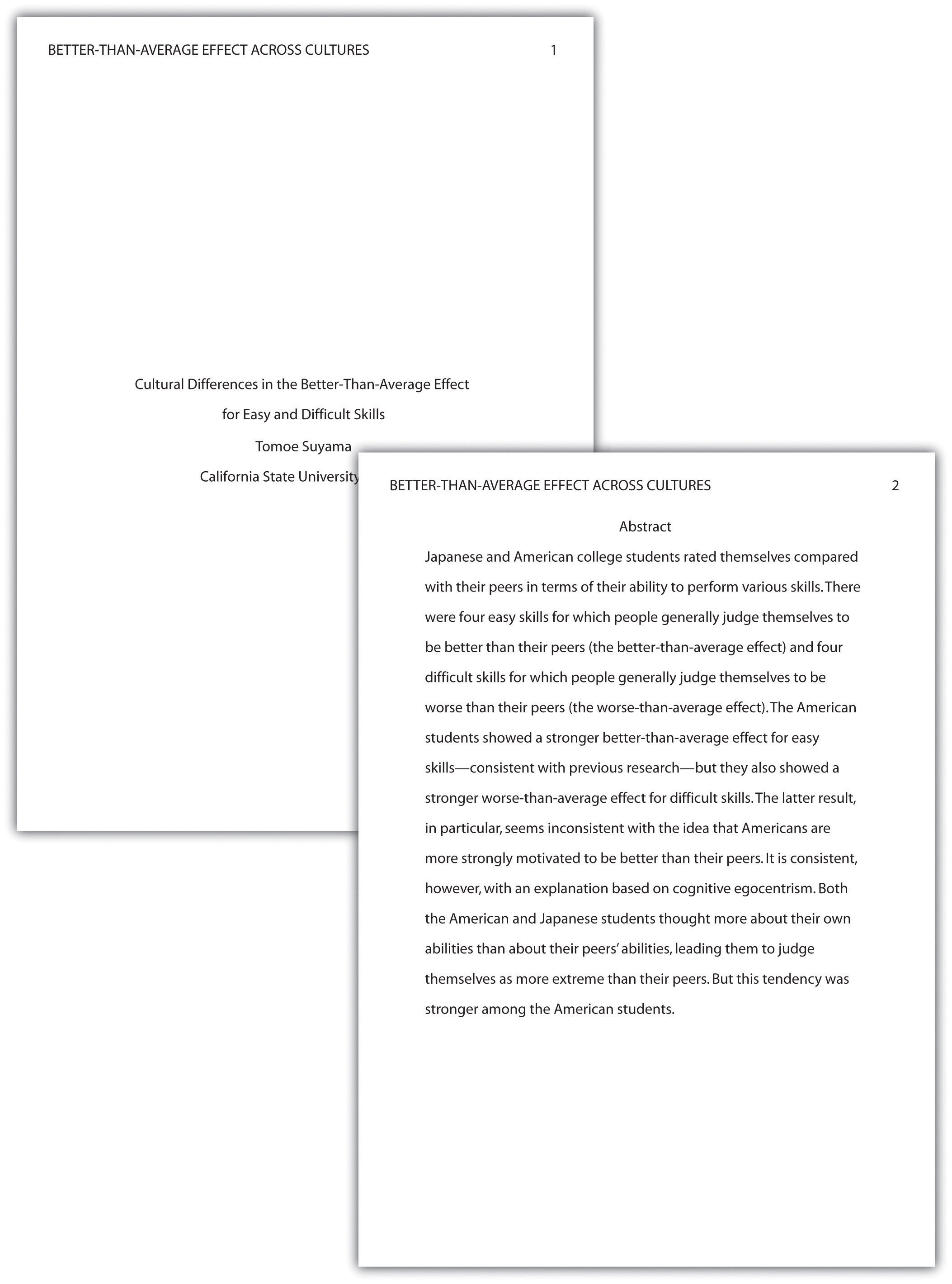
This student paper does not include the author note on the title page. The abstract appears on its own page.
Figure 11.3 Introduction and Method
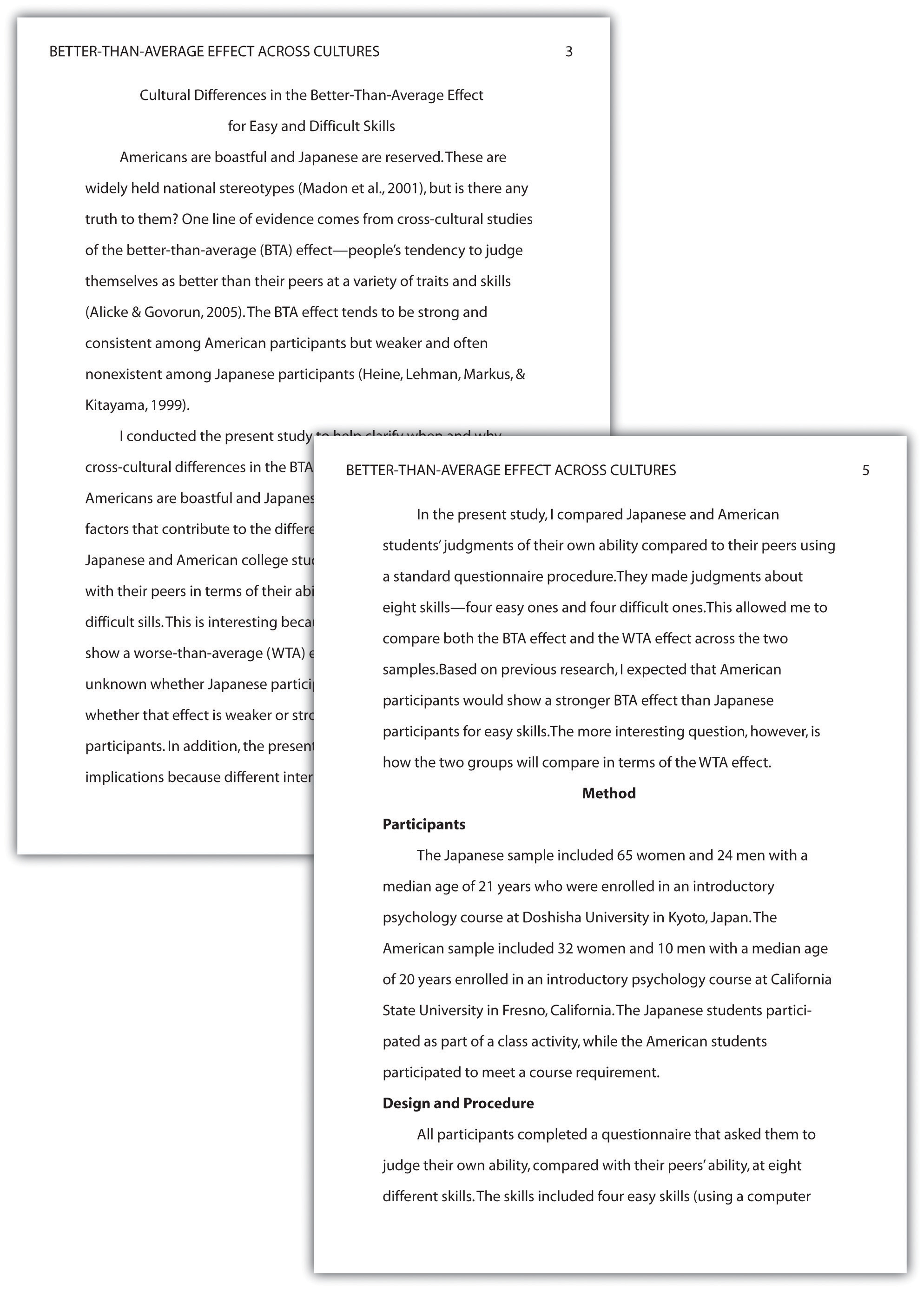
Note that the introduction is headed with the full title, and the method section begins immediately after the introduction ends.
Figure 11.4 Results and Discussion
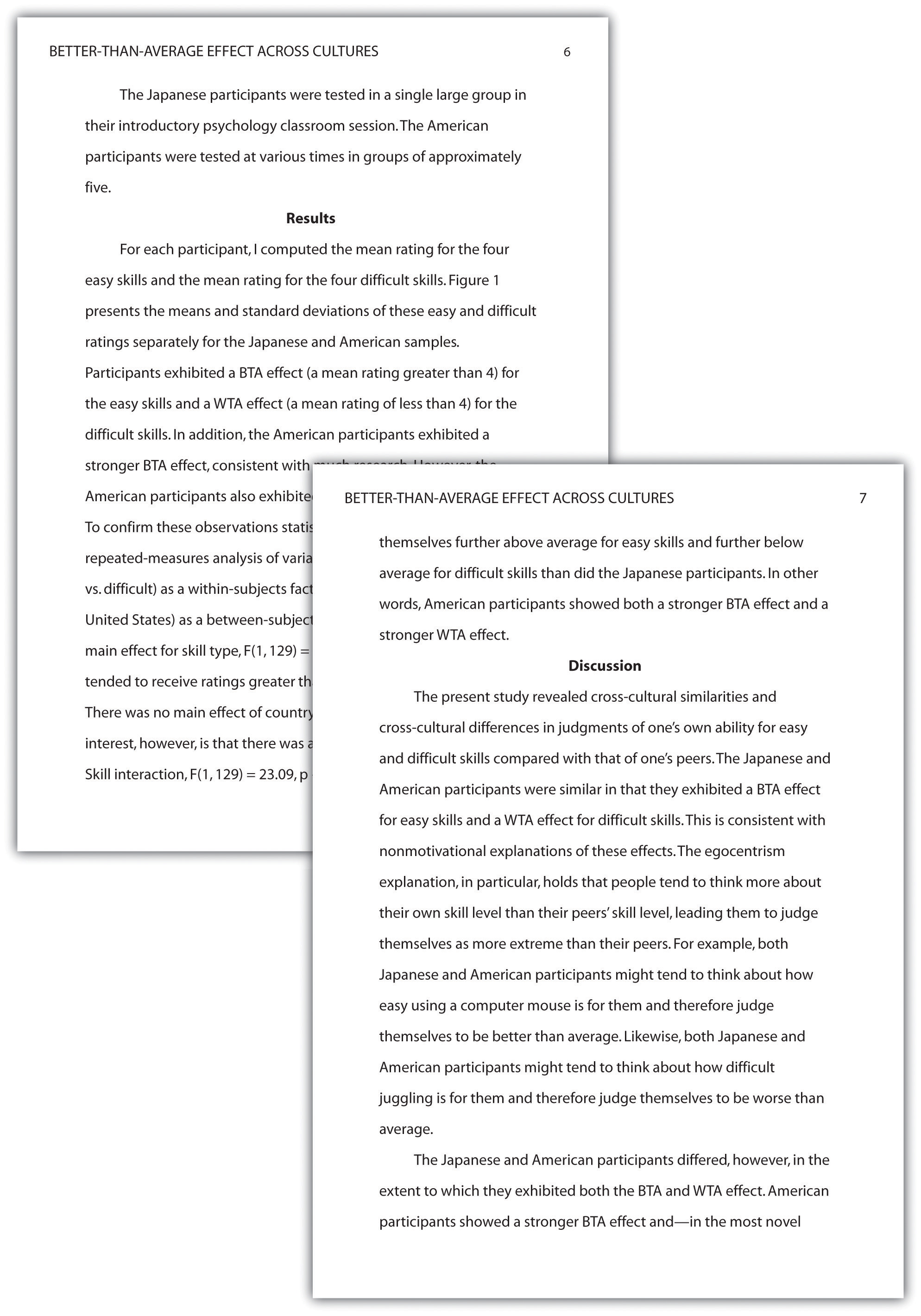
The discussion begins immediately after the results section ends.
Figure 11.5 References and Figure
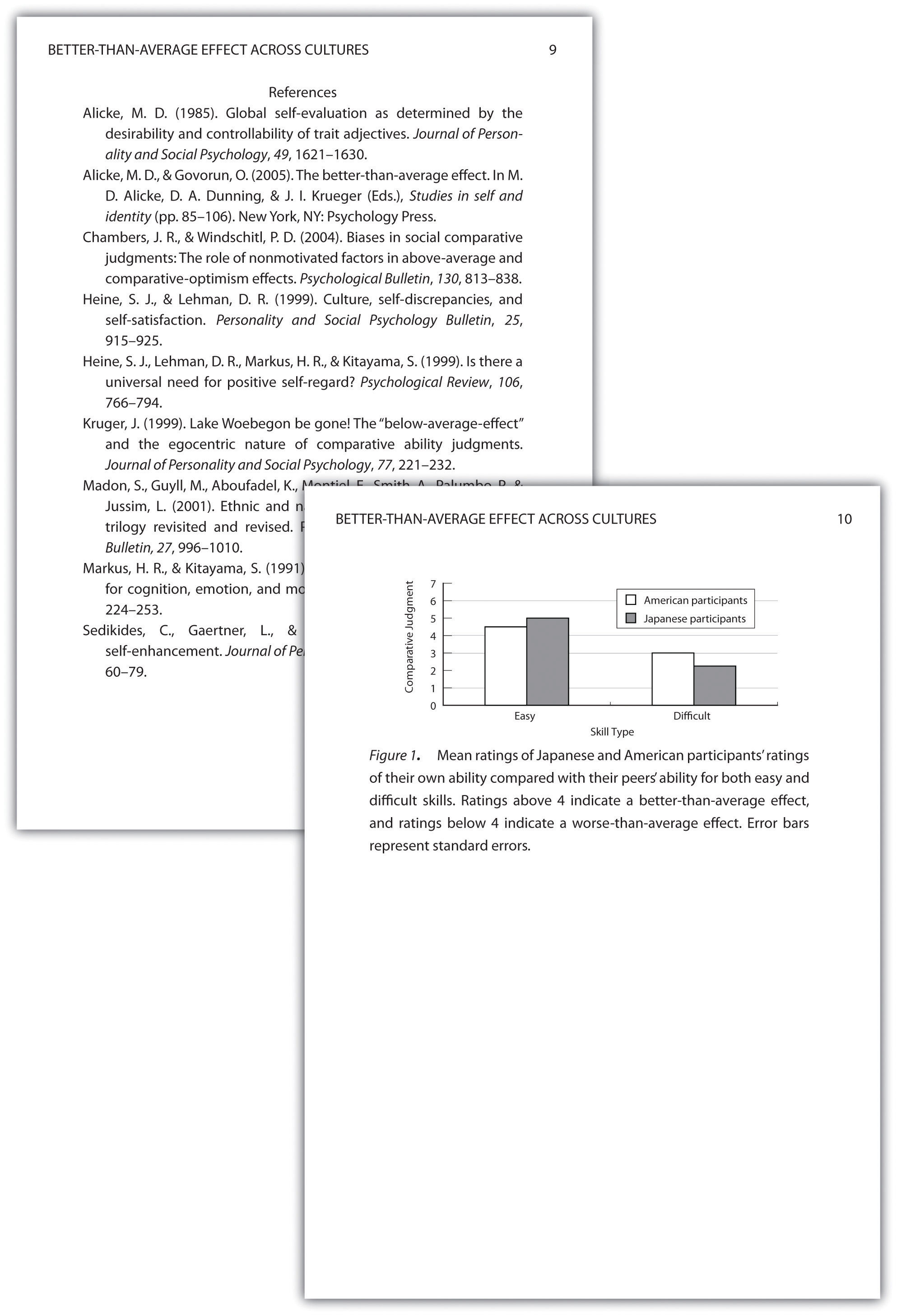
If there were appendixes or tables, they would come before the figure.
Key Takeaways
- An APA-style empirical research report consists of several standard sections. The main ones are the abstract, introduction, method, results, discussion, and references.
- The introduction consists of an opening that presents the research question, a literature review that describes previous research on the topic, and a closing that restates the research question and comments on the method. The literature review constitutes an argument for why the current study is worth doing.
- The method section describes the method in enough detail that another researcher could replicate the study. At a minimum, it consists of a participants subsection and a design and procedure subsection.
- The results section describes the results in an organized fashion. Each primary result is presented in terms of statistical results but also explained in words.
- The discussion typically summarizes the study, discusses theoretical and practical implications and limitations of the study, and offers suggestions for further research.
- Practice: Look through an issue of a general interest professional journal (e.g., Psychological Science ). Read the opening of the first five articles and rate the effectiveness of each one from 1 ( very ineffective ) to 5 ( very effective ). Write a sentence or two explaining each rating.
- Practice: Find a recent article in a professional journal and identify where the opening, literature review, and closing of the introduction begin and end.
- Practice: Find a recent article in a professional journal and highlight in a different color each of the following elements in the discussion: summary, theoretical implications, practical implications, limitations, and suggestions for future research.
Bem, D. J. (2003). Writing the empirical journal article. In J. M. Darley, M. P. Zanna, & H. R. Roediger III (Eds.), The compleat academic: A practical guide for the beginning social scientist (2nd ed.). Washington, DC: American Psychological Association.
Darley, J. M., & Latané, B. (1968). Bystander intervention in emergencies: Diffusion of responsibility. Journal of Personality and Social Psychology, 4 , 377–383.
Research Methods in Psychology Copyright © 2016 by University of Minnesota is licensed under a Creative Commons Attribution-NonCommercial-ShareAlike 4.0 International License , except where otherwise noted.
Research Methods In Psychology
Saul Mcleod, PhD
Editor-in-Chief for Simply Psychology
BSc (Hons) Psychology, MRes, PhD, University of Manchester
Saul Mcleod, PhD., is a qualified psychology teacher with over 18 years of experience in further and higher education. He has been published in peer-reviewed journals, including the Journal of Clinical Psychology.
Learn about our Editorial Process
Olivia Guy-Evans, MSc
Associate Editor for Simply Psychology
BSc (Hons) Psychology, MSc Psychology of Education
Olivia Guy-Evans is a writer and associate editor for Simply Psychology. She has previously worked in healthcare and educational sectors.
Research methods in psychology are systematic procedures used to observe, describe, predict, and explain behavior and mental processes. They include experiments, surveys, case studies, and naturalistic observations, ensuring data collection is objective and reliable to understand and explain psychological phenomena.

Hypotheses are statements about the prediction of the results, that can be verified or disproved by some investigation.
There are four types of hypotheses :
- Null Hypotheses (H0 ) – these predict that no difference will be found in the results between the conditions. Typically these are written ‘There will be no difference…’
- Alternative Hypotheses (Ha or H1) – these predict that there will be a significant difference in the results between the two conditions. This is also known as the experimental hypothesis.
- One-tailed (directional) hypotheses – these state the specific direction the researcher expects the results to move in, e.g. higher, lower, more, less. In a correlation study, the predicted direction of the correlation can be either positive or negative.
- Two-tailed (non-directional) hypotheses – these state that a difference will be found between the conditions of the independent variable but does not state the direction of a difference or relationship. Typically these are always written ‘There will be a difference ….’
All research has an alternative hypothesis (either a one-tailed or two-tailed) and a corresponding null hypothesis.
Once the research is conducted and results are found, psychologists must accept one hypothesis and reject the other.
So, if a difference is found, the Psychologist would accept the alternative hypothesis and reject the null. The opposite applies if no difference is found.
Sampling techniques
Sampling is the process of selecting a representative group from the population under study.

A sample is the participants you select from a target population (the group you are interested in) to make generalizations about.
Representative means the extent to which a sample mirrors a researcher’s target population and reflects its characteristics.
Generalisability means the extent to which their findings can be applied to the larger population of which their sample was a part.
- Volunteer sample : where participants pick themselves through newspaper adverts, noticeboards or online.
- Opportunity sampling : also known as convenience sampling , uses people who are available at the time the study is carried out and willing to take part. It is based on convenience.
- Random sampling : when every person in the target population has an equal chance of being selected. An example of random sampling would be picking names out of a hat.
- Systematic sampling : when a system is used to select participants. Picking every Nth person from all possible participants. N = the number of people in the research population / the number of people needed for the sample.
- Stratified sampling : when you identify the subgroups and select participants in proportion to their occurrences.
- Snowball sampling : when researchers find a few participants, and then ask them to find participants themselves and so on.
- Quota sampling : when researchers will be told to ensure the sample fits certain quotas, for example they might be told to find 90 participants, with 30 of them being unemployed.
Experiments always have an independent and dependent variable .
- The independent variable is the one the experimenter manipulates (the thing that changes between the conditions the participants are placed into). It is assumed to have a direct effect on the dependent variable.
- The dependent variable is the thing being measured, or the results of the experiment.

Operationalization of variables means making them measurable/quantifiable. We must use operationalization to ensure that variables are in a form that can be easily tested.
For instance, we can’t really measure ‘happiness’, but we can measure how many times a person smiles within a two-hour period.
By operationalizing variables, we make it easy for someone else to replicate our research. Remember, this is important because we can check if our findings are reliable.
Extraneous variables are all variables which are not independent variable but could affect the results of the experiment.
It can be a natural characteristic of the participant, such as intelligence levels, gender, or age for example, or it could be a situational feature of the environment such as lighting or noise.
Demand characteristics are a type of extraneous variable that occurs if the participants work out the aims of the research study, they may begin to behave in a certain way.
For example, in Milgram’s research , critics argued that participants worked out that the shocks were not real and they administered them as they thought this was what was required of them.
Extraneous variables must be controlled so that they do not affect (confound) the results.
Randomly allocating participants to their conditions or using a matched pairs experimental design can help to reduce participant variables.
Situational variables are controlled by using standardized procedures, ensuring every participant in a given condition is treated in the same way
Experimental Design
Experimental design refers to how participants are allocated to each condition of the independent variable, such as a control or experimental group.
- Independent design ( between-groups design ): each participant is selected for only one group. With the independent design, the most common way of deciding which participants go into which group is by means of randomization.
- Matched participants design : each participant is selected for only one group, but the participants in the two groups are matched for some relevant factor or factors (e.g. ability; sex; age).
- Repeated measures design ( within groups) : each participant appears in both groups, so that there are exactly the same participants in each group.
- The main problem with the repeated measures design is that there may well be order effects. Their experiences during the experiment may change the participants in various ways.
- They may perform better when they appear in the second group because they have gained useful information about the experiment or about the task. On the other hand, they may perform less well on the second occasion because of tiredness or boredom.
- Counterbalancing is the best way of preventing order effects from disrupting the findings of an experiment, and involves ensuring that each condition is equally likely to be used first and second by the participants.
If we wish to compare two groups with respect to a given independent variable, it is essential to make sure that the two groups do not differ in any other important way.
Experimental Methods
All experimental methods involve an iv (independent variable) and dv (dependent variable)..
- Field experiments are conducted in the everyday (natural) environment of the participants. The experimenter still manipulates the IV, but in a real-life setting. It may be possible to control extraneous variables, though such control is more difficult than in a lab experiment.
- Natural experiments are when a naturally occurring IV is investigated that isn’t deliberately manipulated, it exists anyway. Participants are not randomly allocated, and the natural event may only occur rarely.
Case studies are in-depth investigations of a person, group, event, or community. It uses information from a range of sources, such as from the person concerned and also from their family and friends.
Many techniques may be used such as interviews, psychological tests, observations and experiments. Case studies are generally longitudinal: in other words, they follow the individual or group over an extended period of time.
Case studies are widely used in psychology and among the best-known ones carried out were by Sigmund Freud . He conducted very detailed investigations into the private lives of his patients in an attempt to both understand and help them overcome their illnesses.
Case studies provide rich qualitative data and have high levels of ecological validity. However, it is difficult to generalize from individual cases as each one has unique characteristics.
Correlational Studies
Correlation means association; it is a measure of the extent to which two variables are related. One of the variables can be regarded as the predictor variable with the other one as the outcome variable.
Correlational studies typically involve obtaining two different measures from a group of participants, and then assessing the degree of association between the measures.
The predictor variable can be seen as occurring before the outcome variable in some sense. It is called the predictor variable, because it forms the basis for predicting the value of the outcome variable.
Relationships between variables can be displayed on a graph or as a numerical score called a correlation coefficient.

- If an increase in one variable tends to be associated with an increase in the other, then this is known as a positive correlation .
- If an increase in one variable tends to be associated with a decrease in the other, then this is known as a negative correlation .
- A zero correlation occurs when there is no relationship between variables.
After looking at the scattergraph, if we want to be sure that a significant relationship does exist between the two variables, a statistical test of correlation can be conducted, such as Spearman’s rho.
The test will give us a score, called a correlation coefficient . This is a value between 0 and 1, and the closer to 1 the score is, the stronger the relationship between the variables. This value can be both positive e.g. 0.63, or negative -0.63.

A correlation between variables, however, does not automatically mean that the change in one variable is the cause of the change in the values of the other variable. A correlation only shows if there is a relationship between variables.
Correlation does not always prove causation, as a third variable may be involved.

Interview Methods
Interviews are commonly divided into two types: structured and unstructured.
A fixed, predetermined set of questions is put to every participant in the same order and in the same way.
Responses are recorded on a questionnaire, and the researcher presets the order and wording of questions, and sometimes the range of alternative answers.
The interviewer stays within their role and maintains social distance from the interviewee.
There are no set questions, and the participant can raise whatever topics he/she feels are relevant and ask them in their own way. Questions are posed about participants’ answers to the subject
Unstructured interviews are most useful in qualitative research to analyze attitudes and values.
Though they rarely provide a valid basis for generalization, their main advantage is that they enable the researcher to probe social actors’ subjective point of view.
Questionnaire Method
Questionnaires can be thought of as a kind of written interview. They can be carried out face to face, by telephone, or post.
The choice of questions is important because of the need to avoid bias or ambiguity in the questions, ‘leading’ the respondent or causing offense.
- Open questions are designed to encourage a full, meaningful answer using the subject’s own knowledge and feelings. They provide insights into feelings, opinions, and understanding. Example: “How do you feel about that situation?”
- Closed questions can be answered with a simple “yes” or “no” or specific information, limiting the depth of response. They are useful for gathering specific facts or confirming details. Example: “Do you feel anxious in crowds?”
Its other practical advantages are that it is cheaper than face-to-face interviews and can be used to contact many respondents scattered over a wide area relatively quickly.
Observations
There are different types of observation methods :
- Covert observation is where the researcher doesn’t tell the participants they are being observed until after the study is complete. There could be ethical problems or deception and consent with this particular observation method.
- Overt observation is where a researcher tells the participants they are being observed and what they are being observed for.
- Controlled : behavior is observed under controlled laboratory conditions (e.g., Bandura’s Bobo doll study).
- Natural : Here, spontaneous behavior is recorded in a natural setting.
- Participant : Here, the observer has direct contact with the group of people they are observing. The researcher becomes a member of the group they are researching.
- Non-participant (aka “fly on the wall): The researcher does not have direct contact with the people being observed. The observation of participants’ behavior is from a distance

Pilot Study
A pilot study is a small scale preliminary study conducted in order to evaluate the feasibility of the key s teps in a future, full-scale project.
A pilot study is an initial run-through of the procedures to be used in an investigation; it involves selecting a few people and trying out the study on them. It is possible to save time, and in some cases, money, by identifying any flaws in the procedures designed by the researcher.
A pilot study can help the researcher spot any ambiguities (i.e. unusual things) or confusion in the information given to participants or problems with the task devised.
Sometimes the task is too hard, and the researcher may get a floor effect, because none of the participants can score at all or can complete the task – all performances are low.
The opposite effect is a ceiling effect, when the task is so easy that all achieve virtually full marks or top performances and are “hitting the ceiling”.
Research Design
In cross-sectional research , a researcher compares multiple segments of the population at the same time
Sometimes, we want to see how people change over time, as in studies of human development and lifespan. Longitudinal research is a research design in which data-gathering is administered repeatedly over an extended period of time.
In cohort studies , the participants must share a common factor or characteristic such as age, demographic, or occupation. A cohort study is a type of longitudinal study in which researchers monitor and observe a chosen population over an extended period.
Triangulation means using more than one research method to improve the study’s validity.
Reliability
Reliability is a measure of consistency, if a particular measurement is repeated and the same result is obtained then it is described as being reliable.
- Test-retest reliability : assessing the same person on two different occasions which shows the extent to which the test produces the same answers.
- Inter-observer reliability : the extent to which there is an agreement between two or more observers.
Meta-Analysis
A meta-analysis is a systematic review that involves identifying an aim and then searching for research studies that have addressed similar aims/hypotheses.
This is done by looking through various databases, and then decisions are made about what studies are to be included/excluded.
Strengths: Increases the conclusions’ validity as they’re based on a wider range.
Weaknesses: Research designs in studies can vary, so they are not truly comparable.
Peer Review
A researcher submits an article to a journal. The choice of the journal may be determined by the journal’s audience or prestige.
The journal selects two or more appropriate experts (psychologists working in a similar field) to peer review the article without payment. The peer reviewers assess: the methods and designs used, originality of the findings, the validity of the original research findings and its content, structure and language.
Feedback from the reviewer determines whether the article is accepted. The article may be: Accepted as it is, accepted with revisions, sent back to the author to revise and re-submit or rejected without the possibility of submission.
The editor makes the final decision whether to accept or reject the research report based on the reviewers comments/ recommendations.
Peer review is important because it prevent faulty data from entering the public domain, it provides a way of checking the validity of findings and the quality of the methodology and is used to assess the research rating of university departments.
Peer reviews may be an ideal, whereas in practice there are lots of problems. For example, it slows publication down and may prevent unusual, new work being published. Some reviewers might use it as an opportunity to prevent competing researchers from publishing work.
Some people doubt whether peer review can really prevent the publication of fraudulent research.
The advent of the internet means that a lot of research and academic comment is being published without official peer reviews than before, though systems are evolving on the internet where everyone really has a chance to offer their opinions and police the quality of research.
Types of Data
- Quantitative data is numerical data e.g. reaction time or number of mistakes. It represents how much or how long, how many there are of something. A tally of behavioral categories and closed questions in a questionnaire collect quantitative data.
- Qualitative data is virtually any type of information that can be observed and recorded that is not numerical in nature and can be in the form of written or verbal communication. Open questions in questionnaires and accounts from observational studies collect qualitative data.
- Primary data is first-hand data collected for the purpose of the investigation.
- Secondary data is information that has been collected by someone other than the person who is conducting the research e.g. taken from journals, books or articles.
Validity means how well a piece of research actually measures what it sets out to, or how well it reflects the reality it claims to represent.
Validity is whether the observed effect is genuine and represents what is actually out there in the world.
- Concurrent validity is the extent to which a psychological measure relates to an existing similar measure and obtains close results. For example, a new intelligence test compared to an established test.
- Face validity : does the test measure what it’s supposed to measure ‘on the face of it’. This is done by ‘eyeballing’ the measuring or by passing it to an expert to check.
- Ecological validit y is the extent to which findings from a research study can be generalized to other settings / real life.
- Temporal validity is the extent to which findings from a research study can be generalized to other historical times.
Features of Science
- Paradigm – A set of shared assumptions and agreed methods within a scientific discipline.
- Paradigm shift – The result of the scientific revolution: a significant change in the dominant unifying theory within a scientific discipline.
- Objectivity – When all sources of personal bias are minimised so not to distort or influence the research process.
- Empirical method – Scientific approaches that are based on the gathering of evidence through direct observation and experience.
- Replicability – The extent to which scientific procedures and findings can be repeated by other researchers.
- Falsifiability – The principle that a theory cannot be considered scientific unless it admits the possibility of being proved untrue.
Statistical Testing
A significant result is one where there is a low probability that chance factors were responsible for any observed difference, correlation, or association in the variables tested.
If our test is significant, we can reject our null hypothesis and accept our alternative hypothesis.
If our test is not significant, we can accept our null hypothesis and reject our alternative hypothesis. A null hypothesis is a statement of no effect.
In Psychology, we use p < 0.05 (as it strikes a balance between making a type I and II error) but p < 0.01 is used in tests that could cause harm like introducing a new drug.
A type I error is when the null hypothesis is rejected when it should have been accepted (happens when a lenient significance level is used, an error of optimism).
A type II error is when the null hypothesis is accepted when it should have been rejected (happens when a stringent significance level is used, an error of pessimism).
Ethical Issues
- Informed consent is when participants are able to make an informed judgment about whether to take part. It causes them to guess the aims of the study and change their behavior.
- To deal with it, we can gain presumptive consent or ask them to formally indicate their agreement to participate but it may invalidate the purpose of the study and it is not guaranteed that the participants would understand.
- Deception should only be used when it is approved by an ethics committee, as it involves deliberately misleading or withholding information. Participants should be fully debriefed after the study but debriefing can’t turn the clock back.
- All participants should be informed at the beginning that they have the right to withdraw if they ever feel distressed or uncomfortable.
- It causes bias as the ones that stayed are obedient and some may not withdraw as they may have been given incentives or feel like they’re spoiling the study. Researchers can offer the right to withdraw data after participation.
- Participants should all have protection from harm . The researcher should avoid risks greater than those experienced in everyday life and they should stop the study if any harm is suspected. However, the harm may not be apparent at the time of the study.
- Confidentiality concerns the communication of personal information. The researchers should not record any names but use numbers or false names though it may not be possible as it is sometimes possible to work out who the researchers were.
BRIEF RESEARCH REPORT article
Visual search strategies and game knowledge in junior australian rules football players: testing potential in talent identification and development article type: original research.

- 1 Biomedical and Health Science, Western Sydney University, Penrith, NSW, Australia
- 2 The MARCS Institute for Brain, Behaviour and Development, Western Sydney University, Penrith, New South Wales, Australia
- 3 Western Sydney University, Penrith, New South Wales, Australia
- 4 University of Bath, Bath, England, United Kingdom
- 5 Quinn Elite Sports, Sydney, Australia
- 6 La Trobe University, Melbourne, Victoria, Australia
The final, formatted version of the article will be published soon.
Select one of your emails
You have multiple emails registered with Frontiers:
Notify me on publication
Please enter your email address:
If you already have an account, please login
You don't have a Frontiers account ? You can register here
This study explored video-based decision-making and eye-movement behaviour as a complementary method to assess the decision-making skills and knowledge of elite junior Australian Rules (AR) Football players. Performance was measured twice over an 18-month period. This approach tested a practical and reliable assessment of decision-making and game knowledge that does not contribute to physical training load. N=59 participants were categorised based on their training age groups, U14 (N=38, Mage13.37±0.47) and U16 (N=21, Mage14.80±0.39). Participants watched 14 brief video clips and provided action choices while wearing eye-movement recording glasses that captured visual search patterns (e.g., fixations).Decision accuracy and speed of decision-making were also recorded. Participants with accurate decisions made significantly faster decisions compared to less skilled players (p <0.001).Further, skilled participants had significantly fewer fixations of shorter duration compared to less skilled participants at both the initial and follow-up testing sessions p <0.0001). This suggests that eye-movement characteristics, remain a relatively stable measure over moderate periods of time. With the ability to differentiate between more and less skilled decision-makers, this proof-of-concept study proposes that examining eye movements in relation to decisionmaking and game knowledge is a viable tool for Talent Identification and Development (TID) to complement current measures. We provide a platform for further development and research in the quest for efficient and effective talent identification processes.
Keywords: talent identification and development, Australian Rules football, eye-movement behaviour, decision-making, sport expertise
Received: 15 Dec 2023; Accepted: 07 May 2024.
Copyright: © 2024 Steel, Kassem, Dogramaci, Pang, Quinn and MacMahon. This is an open-access article distributed under the terms of the Creative Commons Attribution License (CC BY) . The use, distribution or reproduction in other forums is permitted, provided the original author(s) or licensor are credited and that the original publication in this journal is cited, in accordance with accepted academic practice. No use, distribution or reproduction is permitted which does not comply with these terms.
* Correspondence: Kylie A. Steel, Biomedical and Health Science, Western Sydney University, Penrith, 1797, NSW, Australia
Disclaimer: All claims expressed in this article are solely those of the authors and do not necessarily represent those of their affiliated organizations, or those of the publisher, the editors and the reviewers. Any product that may be evaluated in this article or claim that may be made by its manufacturer is not guaranteed or endorsed by the publisher.
Health Science Center
What Can we help you find?
Popular Searches
- Academic Calendar
- Study Abroad
- Majors & Minors
- Request Info

UT Tyler Health Science Center
Build a healthier tomorrow.
Home to the region’s only academic medical center, The University of Texas at Tyler Health Science Center is one of the five campuses of UT Tyler. Two of UT Tyler’s four health-related schools have a presence on this campus: the School of Health Professions and the School of Medicine.
Campus History

Our Beginnings

Joining the University of Texas System

A Name Change

New Programs

Campus Programs and Facilities
The UT Tyler Health Science Center facility offers an array of crucial medical and healthcare education resources, fostering an environment dedicated to excellence in education. From cutting-edge simulation labs to dedicated research spaces, every aspect of the UT Tyler Health Science Center is designed to enhance the educational experience. This dynamic campus is not just a hub for learning; it’s a catalyst for progress in healthcare education and a testament to UT Tyler's commitment to shaping the future of healthcare in the East Texas region.
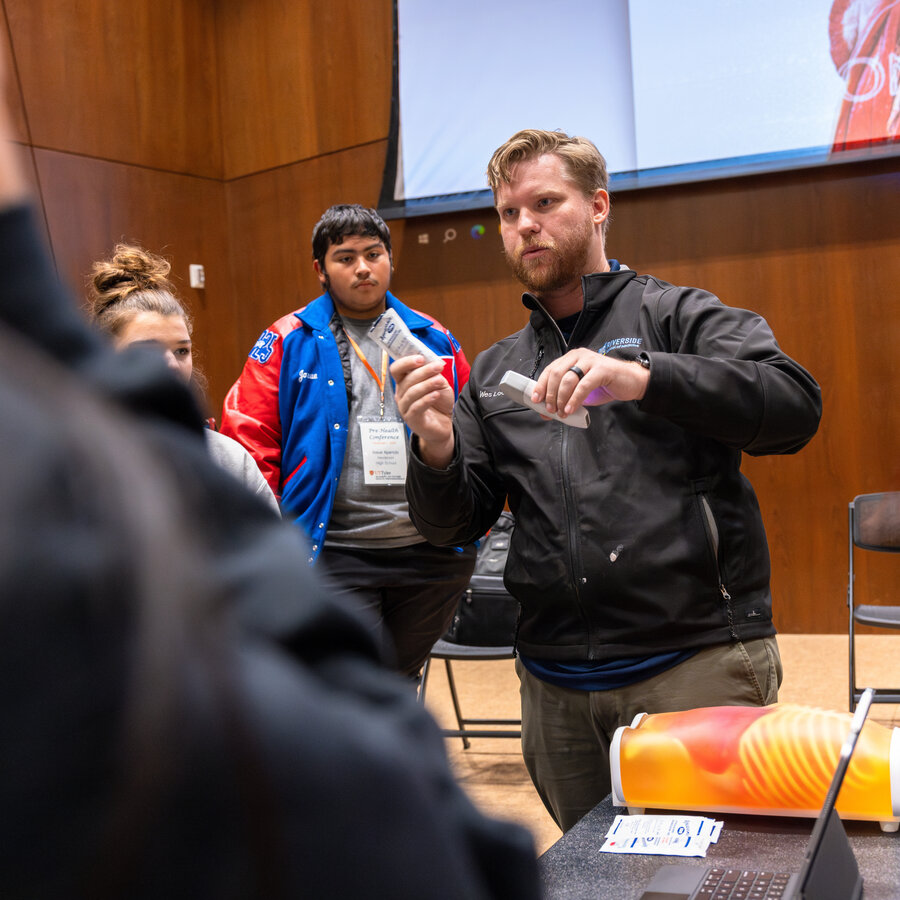
Office of Health Affairs

School of Health Professions

School of Medicine

Center for Biomedical Research
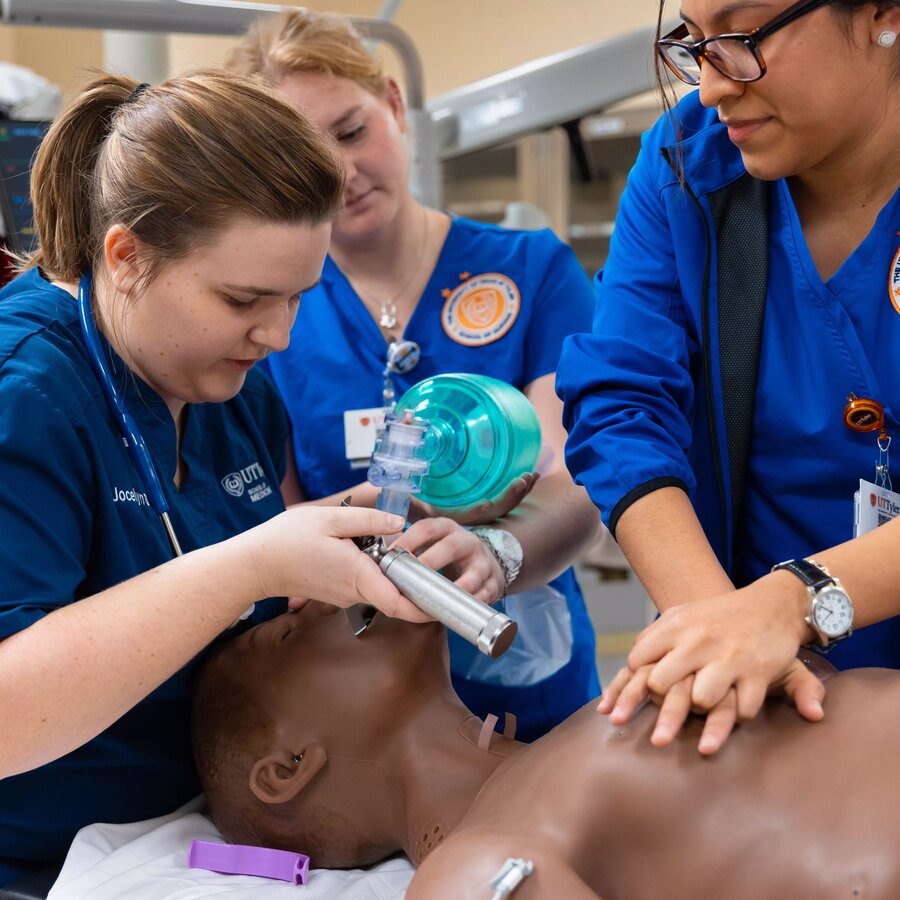
Simulation in Medicine and Immersive Learning Experience Center
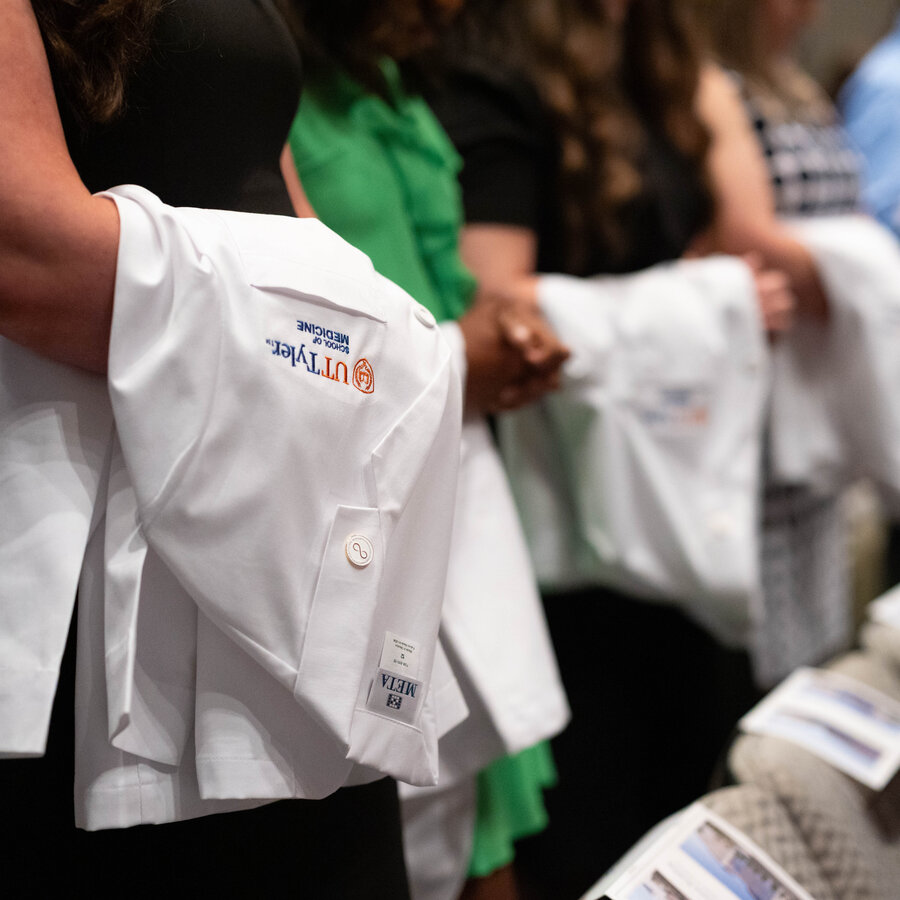
Watson W. Wise Medical Research Library

Public Health Laboratory of East Texas

UT Health North Campus Tyler (UTHET)

HOPE Cancer Center

A Regional Leader in Health Research
UT Tyler pioneers solutions to improve health. Several research centers, including the Center for Mycobacterial Treatment and Discovery and the Center for Biomedical Research, are housed on this campus. The centers build on our history of innovative treatments for lung disease and focus on the health concerns of rural populations through projects funded by agencies like the National Institutes of Health and the Centers for Disease Control and Prevention. Students benefit from hands-on research opportunities and instruction informed by the latest developments in the field.

Dr. Maolin Lu
Assistant Professor of Cellular and Molecular Biology
Meet Professor Lu
Community Outreach and Engagement
Ut health east texas.
In its regional network of hospitals, clinics and other facilities, UT Health East Texas delivers world-class care to thousands of patients each year while conducting clinical trials and training the next generation of professionals through UT Tyler’s unique programs. The UT Tyler Health Science Center is home to UT Health North Campus Tyler .
Public Health Programs
Faculty, staff and students at the UT Tyler Health Science Center campus connect their expertise with local community needs to assist traditionally underserved populations through an array of health and outreach programs, including behavioral health telemedicine services for rural populations, cancer screenings, parental education, lifestyle changes and more.
Pollen and Mold Count
UT Tyler's Health Science Center provides a daily pollen and mold count as a resource to the community. See today's counts as well as prior counts.
Connect With Us
The university of texas at tyler health science center.
Phone: 903.877.7777
We’re pioneering the future of healthcare in East Texas. Find out how you can join us.
11937 U.S. Hwy. 271 Tyler, TX 75708-3154
Thank you for visiting nature.com. You are using a browser version with limited support for CSS. To obtain the best experience, we recommend you use a more up to date browser (or turn off compatibility mode in Internet Explorer). In the meantime, to ensure continued support, we are displaying the site without styles and JavaScript.
- View all journals
- Explore content
- About the journal
- Publish with us
- Sign up for alerts
Psychology Research
Inviting submissions to our guest edited collections in psychology, browse all psychology collections currently open for submissions on this page..
Scientific Reports has expanded its scope to include psychology. We live in a world that is increasingly technology-oriented and driven by data. But to address the challenges of modern times, we must understand a phenomenon that is often not easily captured by data, nor necessarily affected by technology—and that is human behaviour.
Psychologists will find a warm welcome for their work at Scientific Reports and can take advantage of our recent commitment to consideration of Registered Reports . We are also now receiving submissions to several Guest Edited Collections in psychology. Led by our Editorial Board Members, these Collections highlight your research, enhancing its visibility in your field and in the broader research community. The median turnaround time from submission to acceptance for papers submitted to our Guest Edited Collections is 102 days. You can expect to receive an editorial decision within 48 days, and over 55% of papers sent to peer review are published. The journal has an Impact Factor of 4.996, a CiteScore of 6.9 and a Scimago quartile ranking of Q1.
You can also learn more about Scientific Reports ’ policies on Guest Edited Collections here .
To submit a manuscript outside of a Collection, please follow the instructions on this page .
Quick links
- Explore articles by subject
- Guide to authors
- Editorial policies

Want to create or adapt books like this? Learn more about how Pressbooks supports open publishing practices.
Presenting Your Research
49 Writing a Research Report in American Psychological Association (APA) Style
Learning objectives.
- Identify the major sections of an APA-style research report and the basic contents of each section.
- Plan and write an effective APA-style research report.
In this section, we look at how to write an APA-style empirical research report , an article that presents the results of one or more new studies. Recall that the standard sections of an empirical research report provide a kind of outline. Here we consider each of these sections in detail, including what information it contains, how that information is formatted and organized, and tips for writing each section. At the end of this section is a sample APA-style research report that illustrates many of these principles.
Sections of a Research Report
Title page and abstract.
An APA-style research report begins with a title page . The title is centered in the upper half of the page, with each important word capitalized. The title should clearly and concisely (in about 12 words or fewer) communicate the primary variables and research questions. This sometimes requires a main title followed by a subtitle that elaborates on the main title, in which case the main title and subtitle are separated by a colon. Here are some titles from recent issues of professional journals published by the American Psychological Association.
- Sex Differences in Coping Styles and Implications for Depressed Mood
- Effects of Aging and Divided Attention on Memory for Items and Their Contexts
- Computer-Assisted Cognitive Behavioral Therapy for Child Anxiety: Results of a Randomized Clinical Trial
- Virtual Driving and Risk Taking: Do Racing Games Increase Risk-Taking Cognitions, Affect, and Behavior?
Below the title are the authors’ names and, on the next line, their institutional affiliation—the university or other institution where the authors worked when they conducted the research. As we have already seen, the authors are listed in an order that reflects their contribution to the research. When multiple authors have made equal contributions to the research, they often list their names alphabetically or in a randomly determined order.
It’s Soooo Cute! How Informal Should an Article Title Be?
In some areas of psychology, the titles of many empirical research reports are informal in a way that is perhaps best described as “cute.” They usually take the form of a play on words or a well-known expression that relates to the topic under study. Here are some examples from recent issues of the Journal Psychological Science .
- “Smells Like Clean Spirit: Nonconscious Effects of Scent on Cognition and Behavior”
- “Time Crawls: The Temporal Resolution of Infants’ Visual Attention”
- “Scent of a Woman: Men’s Testosterone Responses to Olfactory Ovulation Cues”
- “Apocalypse Soon?: Dire Messages Reduce Belief in Global Warming by Contradicting Just-World Beliefs”
- “Serial vs. Parallel Processing: Sometimes They Look Like Tweedledum and Tweedledee but They Can (and Should) Be Distinguished”
- “How Do I Love Thee? Let Me Count the Words: The Social Effects of Expressive Writing”
Individual researchers differ quite a bit in their preference for such titles. Some use them regularly, while others never use them. What might be some of the pros and cons of using cute article titles?
For articles that are being submitted for publication, the title page also includes an author note that lists the authors’ full institutional affiliations, any acknowledgments the authors wish to make to agencies that funded the research or to colleagues who commented on it, and contact information for the authors. For student papers that are not being submitted for publication—including theses—author notes are generally not necessary.
The abstract is a summary of the study. It is the second page of the manuscript and is headed with the word Abstract . The first line is not indented. The abstract presents the research question, a summary of the method, the basic results, and the most important conclusions. Because the abstract is usually limited to about 200 words, it can be a challenge to write a good one.
Introduction
The introduction begins on the third page of the manuscript. The heading at the top of this page is the full title of the manuscript, with each important word capitalized as on the title page. The introduction includes three distinct subsections, although these are typically not identified by separate headings. The opening introduces the research question and explains why it is interesting, the literature review discusses relevant previous research, and the closing restates the research question and comments on the method used to answer it.
The Opening
The opening , which is usually a paragraph or two in length, introduces the research question and explains why it is interesting. To capture the reader’s attention, researcher Daryl Bem recommends starting with general observations about the topic under study, expressed in ordinary language (not technical jargon)—observations that are about people and their behavior (not about researchers or their research; Bem, 2003 [1] ). Concrete examples are often very useful here. According to Bem, this would be a poor way to begin a research report:
Festinger’s theory of cognitive dissonance received a great deal of attention during the latter part of the 20th century (p. 191)
The following would be much better:
The individual who holds two beliefs that are inconsistent with one another may feel uncomfortable. For example, the person who knows that they enjoy smoking but believes it to be unhealthy may experience discomfort arising from the inconsistency or disharmony between these two thoughts or cognitions. This feeling of discomfort was called cognitive dissonance by social psychologist Leon Festinger (1957), who suggested that individuals will be motivated to remove this dissonance in whatever way they can (p. 191).
After capturing the reader’s attention, the opening should go on to introduce the research question and explain why it is interesting. Will the answer fill a gap in the literature? Will it provide a test of an important theory? Does it have practical implications? Giving readers a clear sense of what the research is about and why they should care about it will motivate them to continue reading the literature review—and will help them make sense of it.
Breaking the Rules
Researcher Larry Jacoby reported several studies showing that a word that people see or hear repeatedly can seem more familiar even when they do not recall the repetitions—and that this tendency is especially pronounced among older adults. He opened his article with the following humorous anecdote:
A friend whose mother is suffering symptoms of Alzheimer’s disease (AD) tells the story of taking her mother to visit a nursing home, preliminary to her mother’s moving there. During an orientation meeting at the nursing home, the rules and regulations were explained, one of which regarded the dining room. The dining room was described as similar to a fine restaurant except that tipping was not required. The absence of tipping was a central theme in the orientation lecture, mentioned frequently to emphasize the quality of care along with the advantages of having paid in advance. At the end of the meeting, the friend’s mother was asked whether she had any questions. She replied that she only had one question: “Should I tip?” (Jacoby, 1999, p. 3)
Although both humor and personal anecdotes are generally discouraged in APA-style writing, this example is a highly effective way to start because it both engages the reader and provides an excellent real-world example of the topic under study.
The Literature Review
Immediately after the opening comes the literature review , which describes relevant previous research on the topic and can be anywhere from several paragraphs to several pages in length. However, the literature review is not simply a list of past studies. Instead, it constitutes a kind of argument for why the research question is worth addressing. By the end of the literature review, readers should be convinced that the research question makes sense and that the present study is a logical next step in the ongoing research process.
Like any effective argument, the literature review must have some kind of structure. For example, it might begin by describing a phenomenon in a general way along with several studies that demonstrate it, then describing two or more competing theories of the phenomenon, and finally presenting a hypothesis to test one or more of the theories. Or it might describe one phenomenon, then describe another phenomenon that seems inconsistent with the first one, then propose a theory that resolves the inconsistency, and finally present a hypothesis to test that theory. In applied research, it might describe a phenomenon or theory, then describe how that phenomenon or theory applies to some important real-world situation, and finally suggest a way to test whether it does, in fact, apply to that situation.
Looking at the literature review in this way emphasizes a few things. First, it is extremely important to start with an outline of the main points that you want to make, organized in the order that you want to make them. The basic structure of your argument, then, should be apparent from the outline itself. Second, it is important to emphasize the structure of your argument in your writing. One way to do this is to begin the literature review by summarizing your argument even before you begin to make it. “In this article, I will describe two apparently contradictory phenomena, present a new theory that has the potential to resolve the apparent contradiction, and finally present a novel hypothesis to test the theory.” Another way is to open each paragraph with a sentence that summarizes the main point of the paragraph and links it to the preceding points. These opening sentences provide the “transitions” that many beginning researchers have difficulty with. Instead of beginning a paragraph by launching into a description of a previous study, such as “Williams (2004) found that…,” it is better to start by indicating something about why you are describing this particular study. Here are some simple examples:
Another example of this phenomenon comes from the work of Williams (2004).
Williams (2004) offers one explanation of this phenomenon.
An alternative perspective has been provided by Williams (2004).
We used a method based on the one used by Williams (2004).
Finally, remember that your goal is to construct an argument for why your research question is interesting and worth addressing—not necessarily why your favorite answer to it is correct. In other words, your literature review must be balanced. If you want to emphasize the generality of a phenomenon, then of course you should discuss various studies that have demonstrated it. However, if there are other studies that have failed to demonstrate it, you should discuss them too. Or if you are proposing a new theory, then of course you should discuss findings that are consistent with that theory. However, if there are other findings that are inconsistent with it, again, you should discuss them too. It is acceptable to argue that the balance of the research supports the existence of a phenomenon or is consistent with a theory (and that is usually the best that researchers in psychology can hope for), but it is not acceptable to ignore contradictory evidence. Besides, a large part of what makes a research question interesting is uncertainty about its answer.
The Closing
The closing of the introduction—typically the final paragraph or two—usually includes two important elements. The first is a clear statement of the main research question and hypothesis. This statement tends to be more formal and precise than in the opening and is often expressed in terms of operational definitions of the key variables. The second is a brief overview of the method and some comment on its appropriateness. Here, for example, is how Darley and Latané (1968) [2] concluded the introduction to their classic article on the bystander effect:
These considerations lead to the hypothesis that the more bystanders to an emergency, the less likely, or the more slowly, any one bystander will intervene to provide aid. To test this proposition it would be necessary to create a situation in which a realistic “emergency” could plausibly occur. Each subject should also be blocked from communicating with others to prevent his getting information about their behavior during the emergency. Finally, the experimental situation should allow for the assessment of the speed and frequency of the subjects’ reaction to the emergency. The experiment reported below attempted to fulfill these conditions. (p. 378)
Thus the introduction leads smoothly into the next major section of the article—the method section.
The method section is where you describe how you conducted your study. An important principle for writing a method section is that it should be clear and detailed enough that other researchers could replicate the study by following your “recipe.” This means that it must describe all the important elements of the study—basic demographic characteristics of the participants, how they were recruited, whether they were randomly assigned to conditions, how the variables were manipulated or measured, how counterbalancing was accomplished, and so on. At the same time, it should avoid irrelevant details such as the fact that the study was conducted in Classroom 37B of the Industrial Technology Building or that the questionnaire was double-sided and completed using pencils.
The method section begins immediately after the introduction ends with the heading “Method” (not “Methods”) centered on the page. Immediately after this is the subheading “Participants,” left justified and in italics. The participants subsection indicates how many participants there were, the number of women and men, some indication of their age, other demographics that may be relevant to the study, and how they were recruited, including any incentives given for participation.
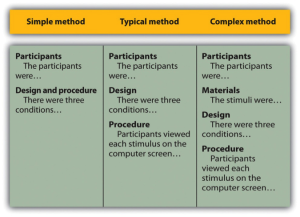
After the participants section, the structure can vary a bit. Figure 11.1 shows three common approaches. In the first, the participants section is followed by a design and procedure subsection, which describes the rest of the method. This works well for methods that are relatively simple and can be described adequately in a few paragraphs. In the second approach, the participants section is followed by separate design and procedure subsections. This works well when both the design and the procedure are relatively complicated and each requires multiple paragraphs.
What is the difference between design and procedure? The design of a study is its overall structure. What were the independent and dependent variables? Was the independent variable manipulated, and if so, was it manipulated between or within subjects? How were the variables operationally defined? The procedure is how the study was carried out. It often works well to describe the procedure in terms of what the participants did rather than what the researchers did. For example, the participants gave their informed consent, read a set of instructions, completed a block of four practice trials, completed a block of 20 test trials, completed two questionnaires, and were debriefed and excused.
In the third basic way to organize a method section, the participants subsection is followed by a materials subsection before the design and procedure subsections. This works well when there are complicated materials to describe. This might mean multiple questionnaires, written vignettes that participants read and respond to, perceptual stimuli, and so on. The heading of this subsection can be modified to reflect its content. Instead of “Materials,” it can be “Questionnaires,” “Stimuli,” and so on. The materials subsection is also a good place to refer to the reliability and/or validity of the measures. This is where you would present test-retest correlations, Cronbach’s α, or other statistics to show that the measures are consistent across time and across items and that they accurately measure what they are intended to measure.
The results section is where you present the main results of the study, including the results of the statistical analyses. Although it does not include the raw data—individual participants’ responses or scores—researchers should save their raw data and make them available to other researchers who request them. Many journals encourage the open sharing of raw data online, and some now require open data and materials before publication.
Although there are no standard subsections, it is still important for the results section to be logically organized. Typically it begins with certain preliminary issues. One is whether any participants or responses were excluded from the analyses and why. The rationale for excluding data should be described clearly so that other researchers can decide whether it is appropriate. A second preliminary issue is how multiple responses were combined to produce the primary variables in the analyses. For example, if participants rated the attractiveness of 20 stimulus people, you might have to explain that you began by computing the mean attractiveness rating for each participant. Or if they recalled as many items as they could from study list of 20 words, did you count the number correctly recalled, compute the percentage correctly recalled, or perhaps compute the number correct minus the number incorrect? A final preliminary issue is whether the manipulation was successful. This is where you would report the results of any manipulation checks.
The results section should then tackle the primary research questions, one at a time. Again, there should be a clear organization. One approach would be to answer the most general questions and then proceed to answer more specific ones. Another would be to answer the main question first and then to answer secondary ones. Regardless, Bem (2003) [3] suggests the following basic structure for discussing each new result:
- Remind the reader of the research question.
- Give the answer to the research question in words.
- Present the relevant statistics.
- Qualify the answer if necessary.
- Summarize the result.
Notice that only Step 3 necessarily involves numbers. The rest of the steps involve presenting the research question and the answer to it in words. In fact, the basic results should be clear even to a reader who skips over the numbers.
The discussion is the last major section of the research report. Discussions usually consist of some combination of the following elements:
- Summary of the research
- Theoretical implications
- Practical implications
- Limitations
- Suggestions for future research
The discussion typically begins with a summary of the study that provides a clear answer to the research question. In a short report with a single study, this might require no more than a sentence. In a longer report with multiple studies, it might require a paragraph or even two. The summary is often followed by a discussion of the theoretical implications of the research. Do the results provide support for any existing theories? If not, how can they be explained? Although you do not have to provide a definitive explanation or detailed theory for your results, you at least need to outline one or more possible explanations. In applied research—and often in basic research—there is also some discussion of the practical implications of the research. How can the results be used, and by whom, to accomplish some real-world goal?
The theoretical and practical implications are often followed by a discussion of the study’s limitations. Perhaps there are problems with its internal or external validity. Perhaps the manipulation was not very effective or the measures not very reliable. Perhaps there is some evidence that participants did not fully understand their task or that they were suspicious of the intent of the researchers. Now is the time to discuss these issues and how they might have affected the results. But do not overdo it. All studies have limitations, and most readers will understand that a different sample or different measures might have produced different results. Unless there is good reason to think they would have, however, there is no reason to mention these routine issues. Instead, pick two or three limitations that seem like they could have influenced the results, explain how they could have influenced the results, and suggest ways to deal with them.
Most discussions end with some suggestions for future research. If the study did not satisfactorily answer the original research question, what will it take to do so? What new research questions has the study raised? This part of the discussion, however, is not just a list of new questions. It is a discussion of two or three of the most important unresolved issues. This means identifying and clarifying each question, suggesting some alternative answers, and even suggesting ways they could be studied.
Finally, some researchers are quite good at ending their articles with a sweeping or thought-provoking conclusion. Darley and Latané (1968) [4] , for example, ended their article on the bystander effect by discussing the idea that whether people help others may depend more on the situation than on their personalities. Their final sentence is, “If people understand the situational forces that can make them hesitate to intervene, they may better overcome them” (p. 383). However, this kind of ending can be difficult to pull off. It can sound overreaching or just banal and end up detracting from the overall impact of the article. It is often better simply to end by returning to the problem or issue introduced in your opening paragraph and clearly stating how your research has addressed that issue or problem.
The references section begins on a new page with the heading “References” centered at the top of the page. All references cited in the text are then listed in the format presented earlier. They are listed alphabetically by the last name of the first author. If two sources have the same first author, they are listed alphabetically by the last name of the second author. If all the authors are the same, then they are listed chronologically by the year of publication. Everything in the reference list is double-spaced both within and between references.
Appendices, Tables, and Figures
Appendices, tables, and figures come after the references. An appendix is appropriate for supplemental material that would interrupt the flow of the research report if it were presented within any of the major sections. An appendix could be used to present lists of stimulus words, questionnaire items, detailed descriptions of special equipment or unusual statistical analyses, or references to the studies that are included in a meta-analysis. Each appendix begins on a new page. If there is only one, the heading is “Appendix,” centered at the top of the page. If there is more than one, the headings are “Appendix A,” “Appendix B,” and so on, and they appear in the order they were first mentioned in the text of the report.
After any appendices come tables and then figures. Tables and figures are both used to present results. Figures can also be used to display graphs, illustrate theories (e.g., in the form of a flowchart), display stimuli, outline procedures, and present many other kinds of information. Each table and figure appears on its own page. Tables are numbered in the order that they are first mentioned in the text (“Table 1,” “Table 2,” and so on). Figures are numbered the same way (“Figure 1,” “Figure 2,” and so on). A brief explanatory title, with the important words capitalized, appears above each table. Each figure is given a brief explanatory caption, where (aside from proper nouns or names) only the first word of each sentence is capitalized. More details on preparing APA-style tables and figures are presented later in the book.
Sample APA-Style Research Report
Figures 11.2, 11.3, 11.4, and 11.5 show some sample pages from an APA-style empirical research report originally written by undergraduate student Tomoe Suyama at California State University, Fresno. The main purpose of these figures is to illustrate the basic organization and formatting of an APA-style empirical research report, although many high-level and low-level style conventions can be seen here too.
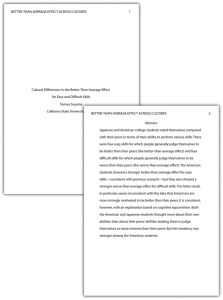
Image Description
Figure 11.1 image description: Table showing three ways of organizing an APA-style method section.
In the simple method, there are two subheadings: “Participants” (which might begin “The participants were…”) and “Design and procedure” (which might begin “There were three conditions…”).
In the typical method, there are three subheadings: “Participants” (“The participants were…”), “Design” (“There were three conditions…”), and “Procedure” (“Participants viewed each stimulus on the computer screen…”).
In the complex method, there are four subheadings: “Participants” (“The participants were…”), “Materials” (“The stimuli were…”), “Design” (“There were three conditions…”), and “Procedure” (“Participants viewed each stimulus on the computer screen…”). [Return to Figure 11.1]
- Bem, D. J. (2003). Writing the empirical journal article. In J. M. Darley, M. P. Zanna, & H. R. Roediger III (Eds.), The complete academic: A practical guide for the beginning social scientist (2nd ed.). Washington, DC: American Psychological Association. ↵
- Darley, J. M., & Latané, B. (1968). Bystander intervention in emergencies: Diffusion of responsibility. Journal of Personality and Social Psychology, 4 , 377–383. ↵
- Bem, D. J. (2003). Writing the empirical journal article. In J. M. Darley, M. P. Zanna, & H. R. Roediger III (Eds.), The complete academic: A practical guide for the beginning social scientist (2nd ed.). Washington, DC: American Psychological Association. ↵
- Darley, J. M., & Latané, B. (1968). Bystander intervention in emergencies: Diffusion of responsibility. Journal of Personality and Social Psychology, 4 , 377–383. ↵
An article that presents the results of one or more new studies.
A brief summary of the study's research question, methods, results and conclusions.
Describes relevant previous research on the topic and can be anywhere from several paragraphs to several pages in length.
Where you present the main results of the study, including the results of the statistical analyses.
Research Methods in Psychology Copyright © 2023 by William L. Kelemen, Rajiv S. Jhangiani, I-Chant A. Chiang, Carrie Cuttler, & Dana C. Leighton is licensed under a Creative Commons Attribution-NonCommercial-ShareAlike 4.0 International License , except where otherwise noted.
Share This Book

IMAGES
VIDEO
COMMENTS
An APA-style research report begins with a ... In some areas of psychology, the titles of many empirical research reports are informal in a way that is perhaps best described as "cute." They usually take the form of a play on words or a well-known expression that relates to the topic under study.
Psychological Reports is a bi-monthly peer-reviewed journal that publishes original and creative contributions to the field of general psychology. The journal carries experimental, theoretical, and speculative articles and comments in all areas of psychology. View full journal description. This journal is a member of the Committee on ...
In psychology, a lab report outlines a study's objectives, methods, results, discussion, and conclusions, ensuring clarity and adherence to APA (or relevant) formatting guidelines. A typical lab report would include the following sections: title, abstract, introduction, method, results, and discussion.
The journal publishes cutting-edge research articles and short reports, spanning the entire spectrum of the science of psychology. This journal is the source for the latest findings in cognitive, social, developmental, and health psychology, as well as behavioral neuroscience and biopsychology. View full journal description
Psychology Top 100 of 2023. This collection highlights the most downloaded* psychology research papers published by Scientific Reports in 2023. Featuring authors from around the world, these ...
THE DEPARTMENT OF PSYCHOLOGY GUIDE TO WRITING RESEARCH REPORTS The following set of guidelines provides psychology students at Essex with the basic information for structuring and formatting reports of research in psychology. During your time here this will be an invaluable reference. You are encouraged to refer to this document each time you ...
Psychology articles from across Nature Portfolio. ... Research Open Access 06 May 2024 Scientific Reports. ... Research Highlights 30 Apr 2024 Nature Reviews Psychology. P: 1.
Read the latest Research articles in Psychology from Scientific Reports. ... Development and initial validation of a new self-report measure to assess perceived dependence on tobacco and nicotine ...
A psychology lab report is a paper that describes an experiment. A lab report is organized and written according to the format used in professional journal articles. In your lab report, you will provide an overview of your findings, a background of the topic, your methods, and results. You'll also discuss your findings and your interpretations ...
Psychological Science, the flagship journal of the Association for Psychological Science, is the leading peer-reviewed journal publishing empirical research spanning the entire spectrum of the science of psychology.The journal publishes high quality research articles of general interest and on important topics spanning the entire spectrum of the science of psychology.
Component 1: The Title Page. • On the right side of the header, type the first 2-3 words of your full title followed by the page number. This header will appear on every page of you report. • At the top of the page, type flush left the words "Running head:" followed by an abbreviation of your title in all caps.
Feature Articles, which are full-length articles that focus on a conceptually or theoretically driven empirical contribution (all research strategies and methods, quantitative and qualitative, are considered) or on a theoretical contribution that can shape future research in applied psychology. Research Reports, which are narrower in scope and ...
oping comprehensive reports that will support their review. Guidance is provided for how to best present qualitative research, with rationales and illustrations. The reporting standards for qualitative meta-analyses, which are integrative analy-ses of findings from across primary qualitative research, are presented in Chapter 8.
In research report there are usually six sub-sections: (1) Abstract: This is always written last because it is a very brief summary: Include a one sentence summary, giving the topic to be studied. This may include the hypothesis and some brief theoretical background research, for example the name of the researchers whose work you have replicated.
RESEARCH REPORT (PSYCHOLOGY) A psychology Research Report, or Lab Report, gives an account of an experiment about humanbehaviour. The account not only includes the information about the process of the experiment, but also communicates the relevance, validity, and reliability of the research in a well-developed line of argument. A lab report
In some areas of psychology, the titles of many empirical research reports are informal in a way that is perhaps best described as "cute." They usually take the form of a play on words or a well-known expression that relates to the topic under study. Here are some examples from recent issues of the Journal of Personality and Social Psychology.
These topics include a wide range of issues, from ability tests for employees to research on drugs and the brain, school violence, the impact of AIDS on family members and the ways in which children learn. A variety of resources about psychology are available on the Internet or at any library, including books, journals, newspapers, pamphlets ...
Recently published articles from subdisciplines of psychology covered by more than 90 APA Journals™ publications. For additional free resources (such as article summaries, podcasts, and more), please visit the Highlights in Psychological Research page. Browse and read free articles from APA Journals across the field of psychology, selected by ...
This article is the report of the JARS Group's findings and recommendations. It was approved by the Publications and Communications Board in the summer of 2007 and again in the spring of 2008 and was transmitted to the task force charged with revising the Publication Manual for consideration as it did its work. The content of the report roughly follows the stages of the group's work.
The influence of adolescents essential and non-essential use of technology and Internet addiction on their physical and mental fatigues. Maryam Aziz. , Khansa Chemnad. & Raian Ali.
Olivia Guy-Evans, MSc. Research methods in psychology are systematic procedures used to observe, describe, predict, and explain behavior and mental processes. They include experiments, surveys, case studies, and naturalistic observations, ensuring data collection is objective and reliable to understand and explain psychological phenomena.
This introduction to the special issue on global perspectives frames the collection of articles around recent calls for expanding the focus of research in psychology in general, and school psychology specifically, beyond Western, educated, industrialized, rich, and democratic countries and cross-cultural comparisons with non-Western, educated, industrialized, rich, and democratic Confucian ...
This article is part of the Research Topic Cognitive and Motor Skills in Sports View all 13 articles Visual search strategies and game knowledge in junior Australian rules football players: testing potential in talent identification and development Article type: Original Research
Previous research shows that self-reports may be biased by an initial elevation phenomenon. Controlled experiments in which participants are, for example, randomly allocated to respond to survey items either on 2 measurement occasions (T1 and T2) or only once (T2) have found that people's ratings tend to be higher, on average, for those who are taking the survey for the first time as ...
Several research centers, including the Center for Mycobacterial Treatment and Discovery and the Center for Biomedical Research, are housed on this campus. The centers build on our history of innovative treatments for lung disease and focus on the health concerns of rural populations through projects funded by agencies like the National ...
Scientific Reports has expanded its scope to include psychology. We live in a world that is increasingly technology-oriented and driven by data. But to address the challenges of modern times, we ...
Sections of a Research Report Title Page and Abstract. An APA-style research report begins with a title page. The title is centered in the upper half of the page, with each important word capitalized. ... In some areas of psychology, the titles of many empirical research reports are informal in a way that is perhaps best described as "cute ...
Psychology. Friday, May 10, 2024. European History. United States History. Macroeconomics. Spanish Literature and Culture. Art and Design: Friday, May 10, 2024 (8 p.m. ET), is the deadline for AP Art and Design students to submit their three portfolio components as final in the AP Digital Portfolio.
You can learn more about the methodology used to create this report here.. About Research.com. All research was coordinated by Imed Bouchrika, Ph.D., a computer scientist with a well-established record of collaboration on a number of international research projects with different partners from the academic community.His role was to make sure all data remained unbiased, accurate, and up-to-date.